61 Rustic Western Home Decor Ideas to Transform Your Space with Western Charm

Is there a place in your dreams which exudes the warmth of the Old West, yet feels fresh and inviting at the same time? Have you been wondering how to incorporate that rustic charm into your spaces without going over the top? Well, in this guide, I’ll take you through everything you need to know about rustic western home decor, starting from furniture design, the materials used, to the color palettes that characterize this timeless style.
If you are redecorating a ranch-style living room or simply adding a western touch to your suburban kitchen, this guide offers tips, and design inspiration devoid of abstract ideas, taking you one step closer to realizing the rustic western retreat of your dreams. View the essential furnishings, reclaimed wood, iron accents, and worn leather that evoke honest rustic charm. From the inspiration of wide-open spaces, we will set off onto the dusty trails of this cozy and grounded style.
Get Acquainted With Rustic Western Home Decor
Rustic western home decor style offers an interesting mix of rugged elegance and warm coziness. I believe the secret to nailing this look is a blend of natural elements with some attention to details such as stone fireplaces, wooden beams, aged finishes, and more. It creates a nostalgic yet modern, rustic appeal characteristic of the American frontier, perfect for trend-conscious homebodies.
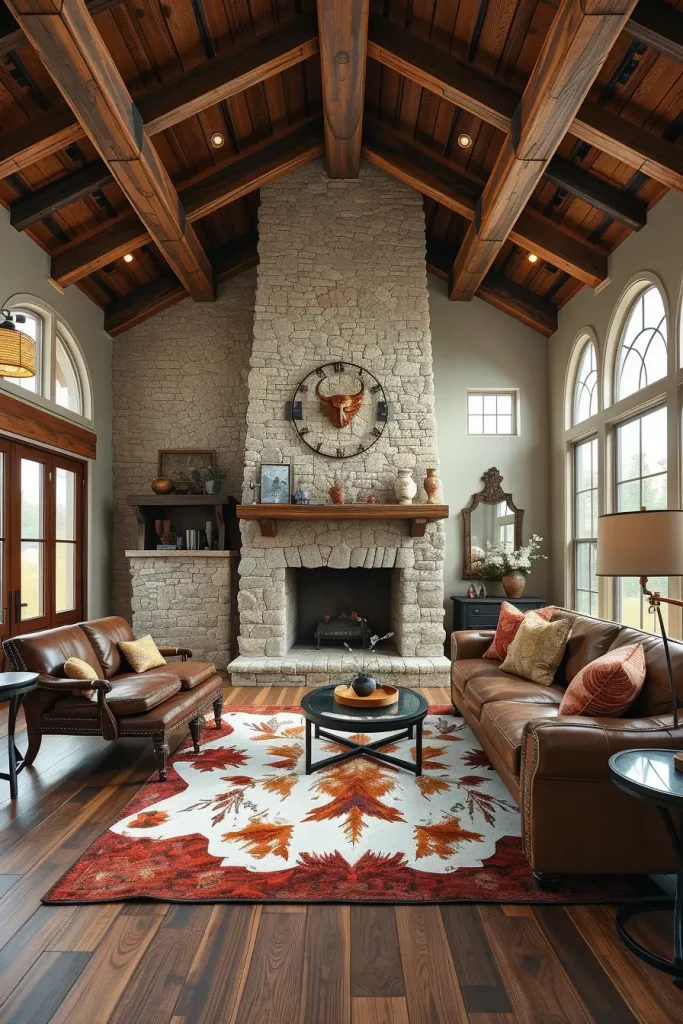
Weathered wood furniture is another one of my favorite elements with distressed details to include as it provides a connection to nature. I also add leather seating, metal trims, and handmade woven textiles to enhance the layered, worn-in quality. Earthy and authentic subdued tones of browns, terracotta red, and warm neutrals provide a cohesive palette.
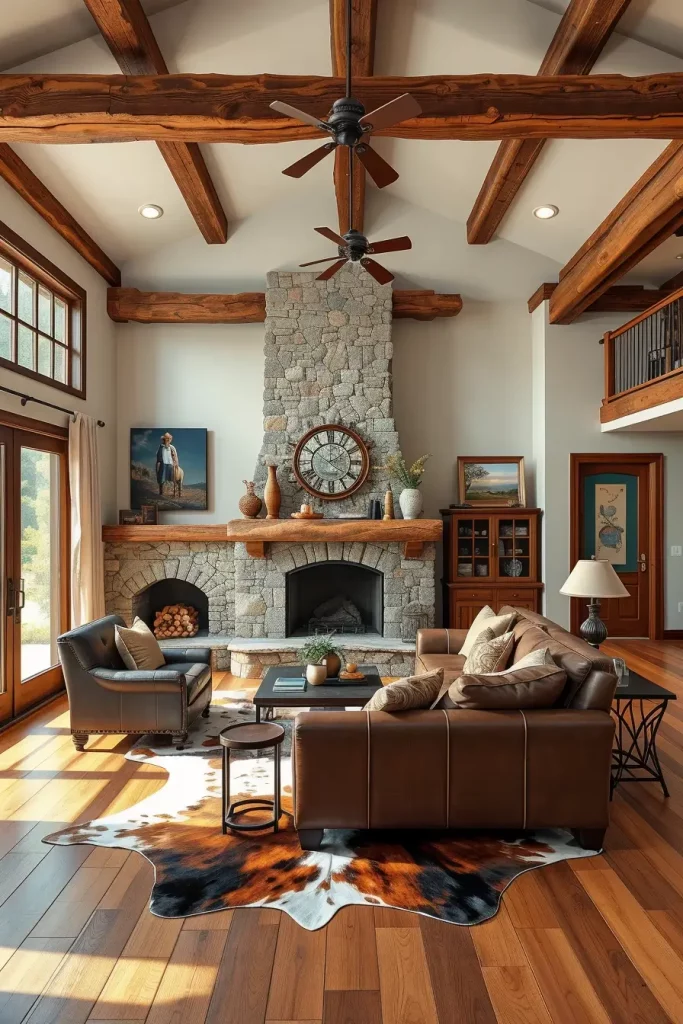
In my opinion, rustic western decor does not mean transforming a house into a saddle’s replica. It is an attempt to design a space that is rich in depth and history while portraying warmth and rootedness. Architectural Digest noted that western style flourishes when you combine the contemporaneous with the ancients. I couldn’t agree more.
To elevate this area further, I suggest integrating a bold statement piece such as a vintage wagon wheel chandelier or a reclaimed barn door to act as both a stylish anchor and a centerpiece that evokes conversation.
Authentic Elements Of Western Style Interiors
In designing a rustic western room, I set out to address the underlying ingredients for this particular style. Those include: weathered wood, stone, wrought iron, and an inviting, toned-down, muted color palette. These materials are visually attractive and evoke a sense of history amd permanence to a space. Authentic western interiors differ with a sense of storytelling; everything has a place.
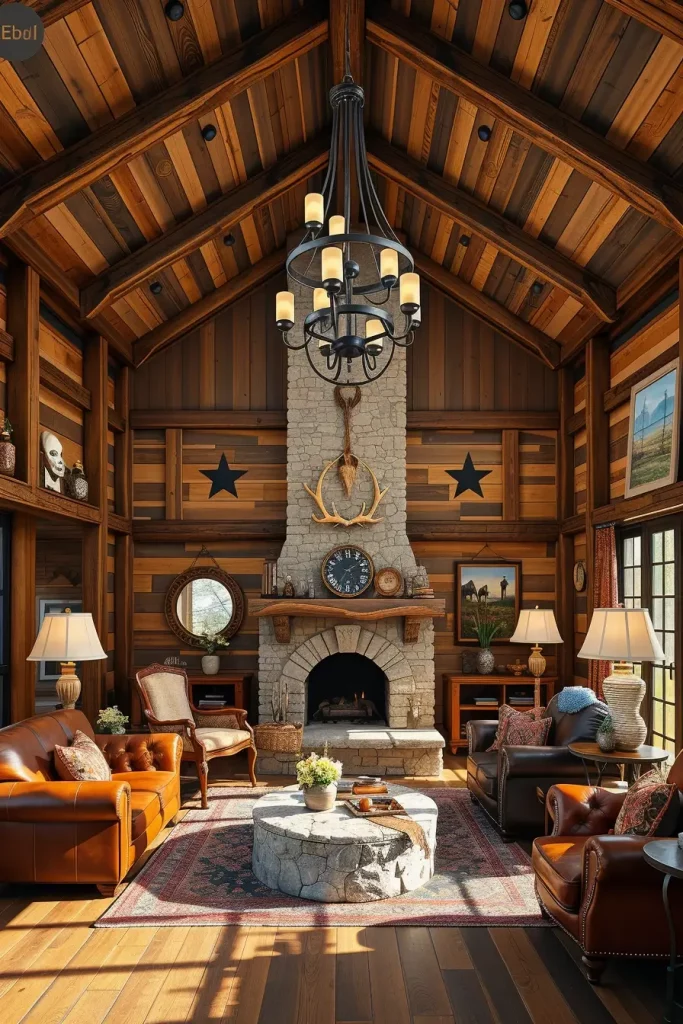
For beams, flooring, and wall panelling, I like to incorporate reclaimed barn wood. This instantly grounds the room in rustic heritage. Iron accents, such as coffee tables, curtain rods, and lantern sconces, add industrial weight and contribute to the stylistic nod. Natural stone features—like a hearth or an accent wall—strengthen the connection to the earth, while western-style furniture upholstered in leather or wooden with exposed grain add striking cohesion.
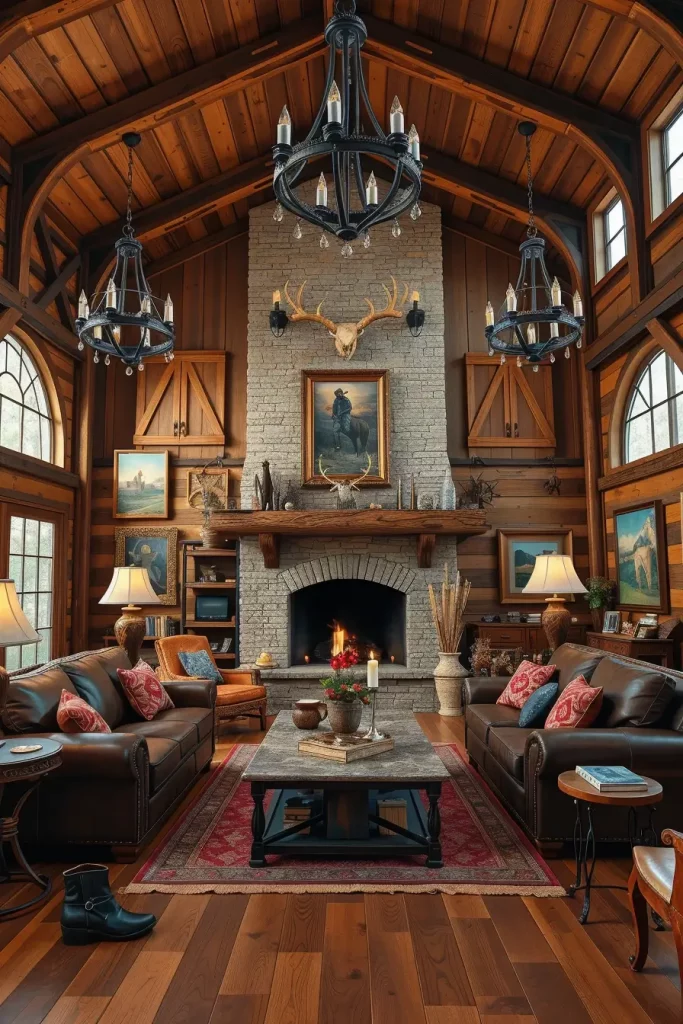
I find authenticity shines best when not overly styled. It’s completely fine for something to look worn, mismatched, or even handcrafted. Joanna Gaines has said many times that imperfections are what add humanity to a space, and I’ve adapted that for my practice. A Navajo rug or a fireplace screen forged of iron and wood carries an essence that mass-produced decor simply cannot replicate.
For this part, I would also add decorative antlers, cowhide accent pieces, or old saddles turned into stools or other features because they tell a story and add texture.
Key Characteristics Of Rustic Western Design
The rustic western aesthetic emphasized layered textures, visible imperfections, and a balance of rustic surfaces with Western designs. I always remind clients that this style is less about direct cowboy imagery and more about the expansive freedom and grit of the American West. Key characteristics are exposed beams, neutral tones, aged surfaces, and taper crafted pieces.
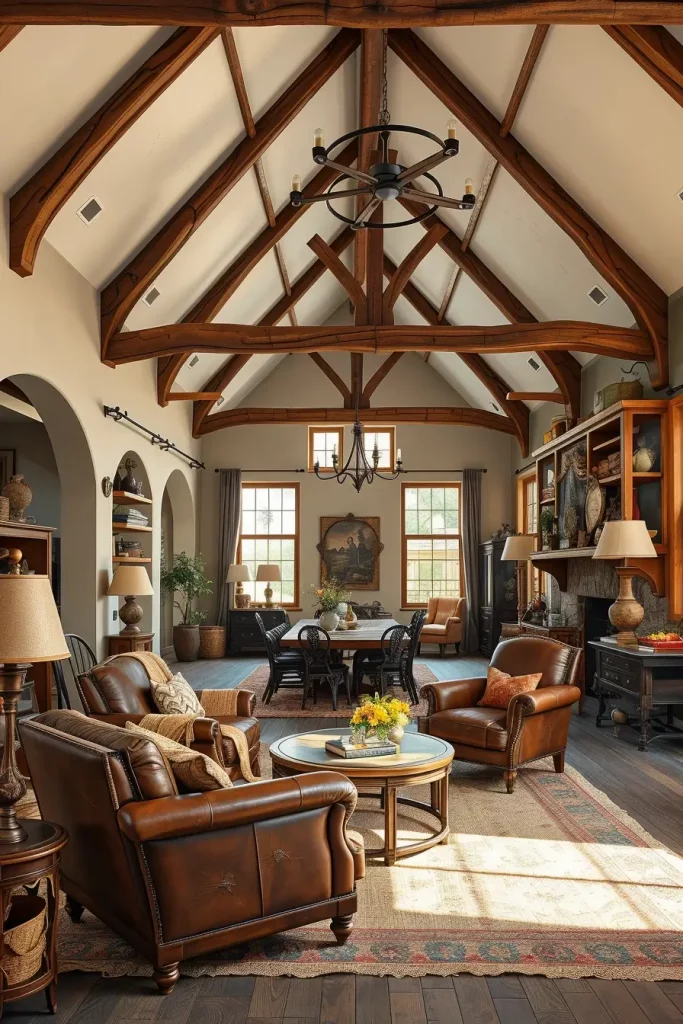
Natural wood materials, especially oak, hickory, and pine with rough-hewn finishes, are my go-to when furnishing a space. I also incorporate leather upholstery with a patina along with handwoven rugs to enhance the space’s tactile dimension. This style’s charm is accentuated with old barn doors repurposed as wall art, iron hooks, and brass hardware. A picture is completed with large stone-clad fireplaces or windows that bathe the space in light.
From my perspective, masculine, coarse materials need to be balanced with subtle soft elements. This interior stylist, Emily Henderson, once said “Contrast brings character,” and this is something I take into consideration when applying it to western design by draping wool throws over leather chairs or putting wooden shelves.
What could be improved? For me, rustic landscapes artwork or vintage-style signs would do the trick best. They add a clear narrative to the room while painting the intended atmosphere.
Furnishing a Space with Natural Elements for a Western Aesthetic
With regards to the rustic western style, the first thing worth noting is the focus on the use of natural elements. These define the essence of any west-style inspired interior. To achieve warmth and honesty in the room, I work with tactile materials: raw textures like stone, leather, wood, and linen. Such materials don’t just age, but develop a certain level of grace as time passes.
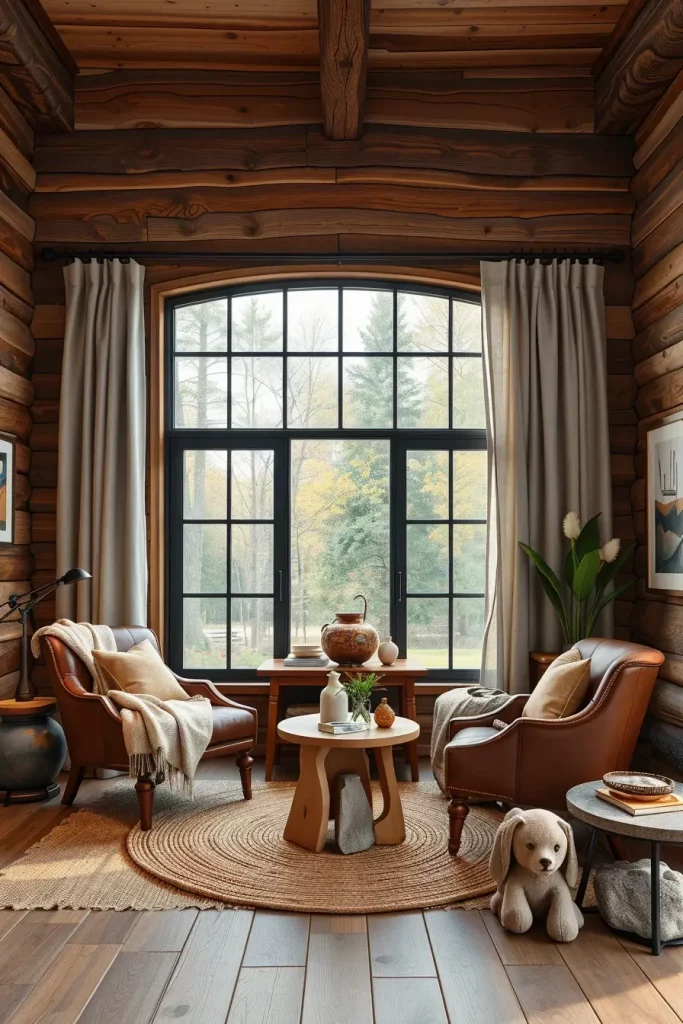
For my designs, I usually go for wide plank wood floors, leather seating, and reclaimed wood coffee tables. To help enhance the space further, I incorporate wool throws, jute rugs, and iron light fixtures. I find that the raw or matte finishes are more appealing, as glossy would detract the rustic charm the materials convey. Additionally, rough cut lumber, stone tiles, and woven wall hangings greatly establish the aesthetic.
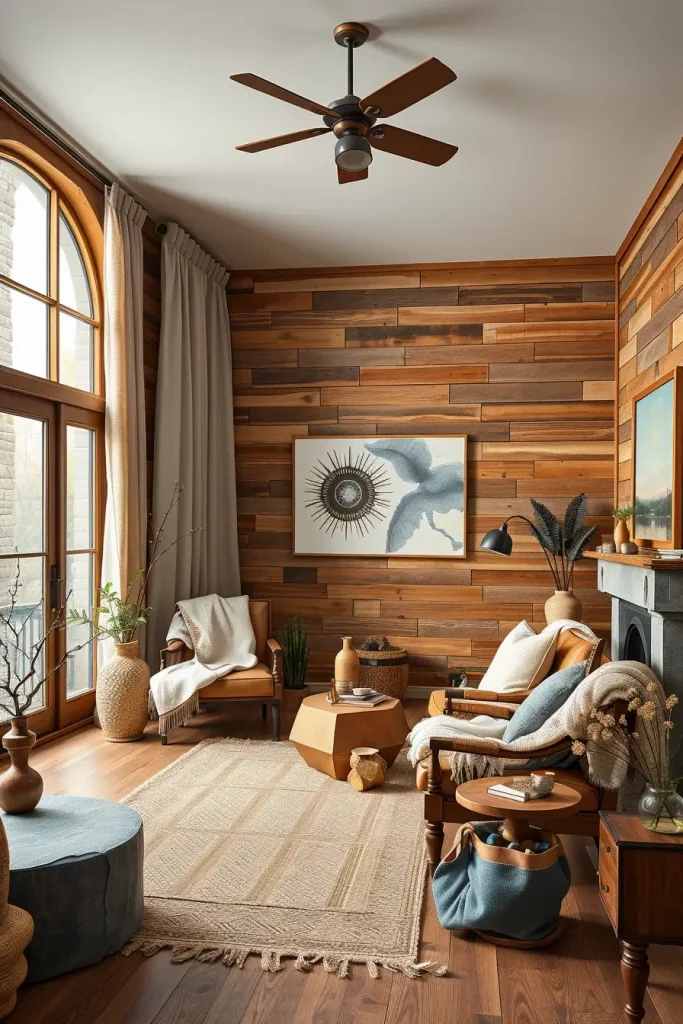
As much as these materials are visually appealing, they also contribute to making a space that feels grounded and intent driven. Authentic design tends to feel more rooted in place, which is the notion that Architecture Digest supports and applies here.
For the reclaimed materials, I would suggest local salvage yards or green building supply stores as they contribute to eco-friendly sourcing.
Mixing Leather And Wood In Western Decor
If there is ever a more true embodiment of Western decor style than leather and wood, I have yet to see it. Unlike other materials, these provide a comforting feeling while still being incredibly durable, which is key for rustic western interiors. Overall, the visual effectiveness of the blend is unparalleled.
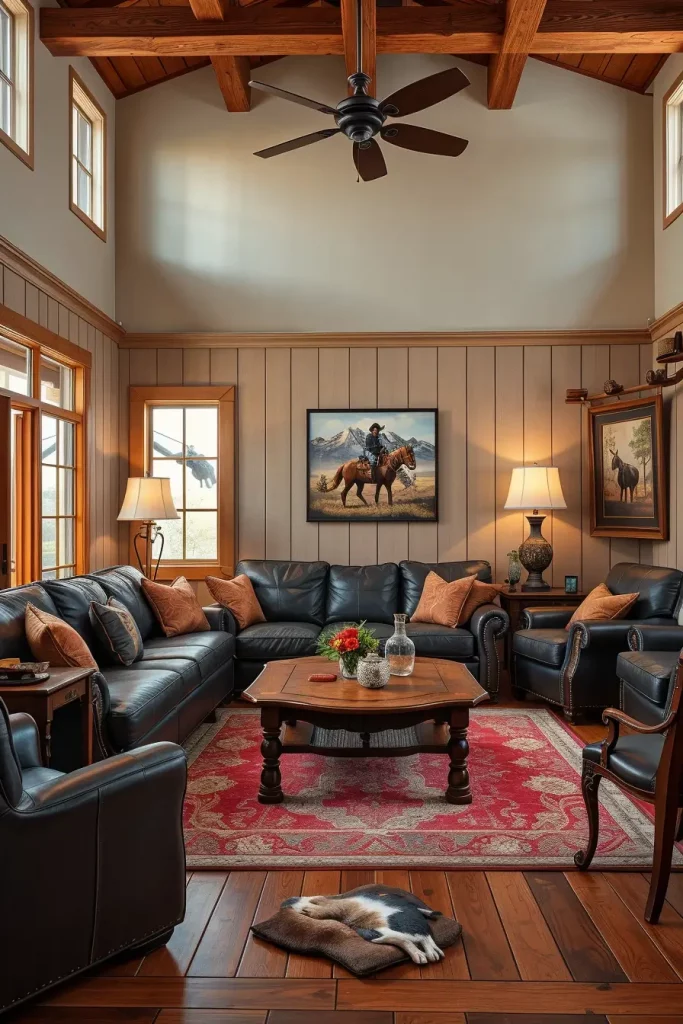
In my interior design projects, I enjoy placing deep leather sofas next to knotty pine coffee tables. Also, a leather-upholstered chair looks good with a carved oak dining table. I also love framing a leather headboard with wood-paneled walls in the bedroom. One important thing to keep in mind is to not have too much matching—it’s best to let the tones change strategically. Adding texture with tooled leather or wood that reveals grain and knots is also helpful.
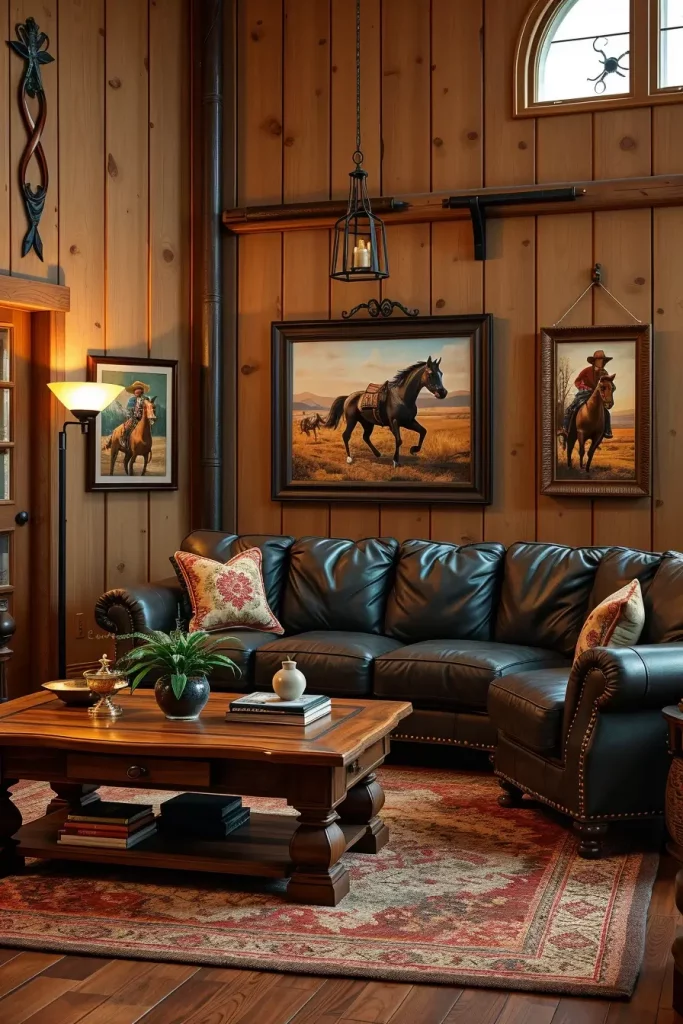
What I appreciate most about this combination is how striking yet understated the look is. As noted by Veranda Magazine, “the quiet elegance of worn-in leather” complements the rustic feel of any room. I too encourage my clients to embrace those surfaces and patinas instead of hiding them which adds charm.
This portion would be more complete with advice about maintaining these materials, such as how to condition leather and protect wood with natural finishes so that the pieces look their best over time.
The Role Of Earth Tones In Western Interiors
When designing a rustic western home, my first step is choosing an earth tones palette. These colors are inspired by the southwestern landscapes of the United States. Warm red rock canyons, desert sand, sun-bleached wood, and blue skies are just some examples. At the same time, earth tones envelop a room with warmth while still providing subtle drama for the eye.
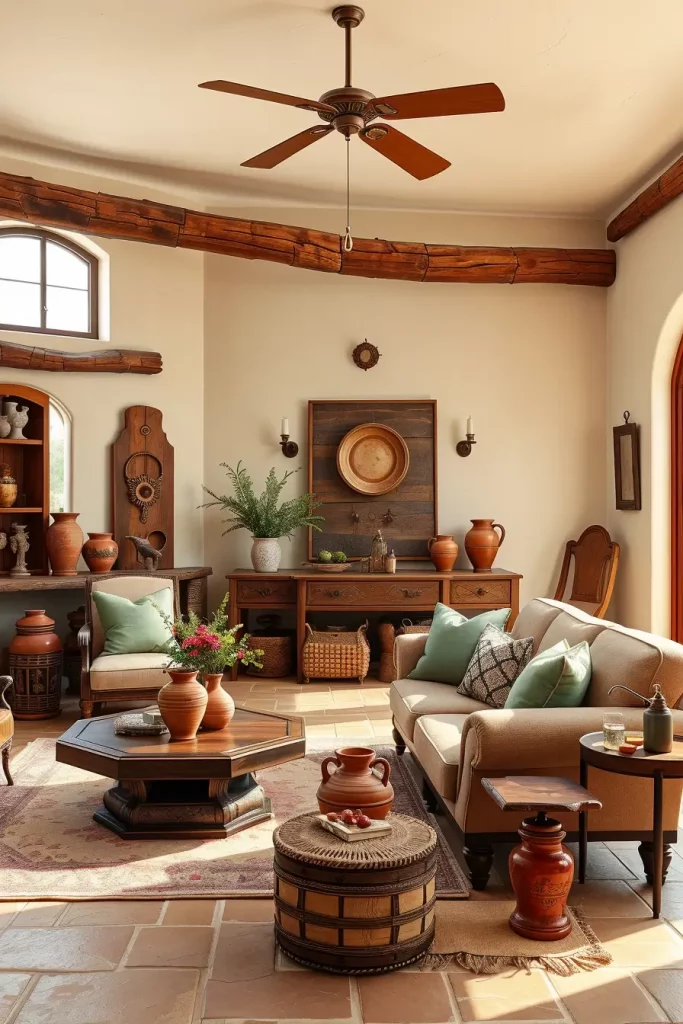
The colors I prefer are terracotta, clay, beige, ochre, dusty blue, and sage green. These shades accentuate the wooden beams, stone fireplaces, and rustic fabrics in addition to providing a timeless backdrop for furniture such as a distressed leather armchair and a reclaimed wood dining set. I Love how accent pillows in soft red colors completed with tribal prints unify the color palette.
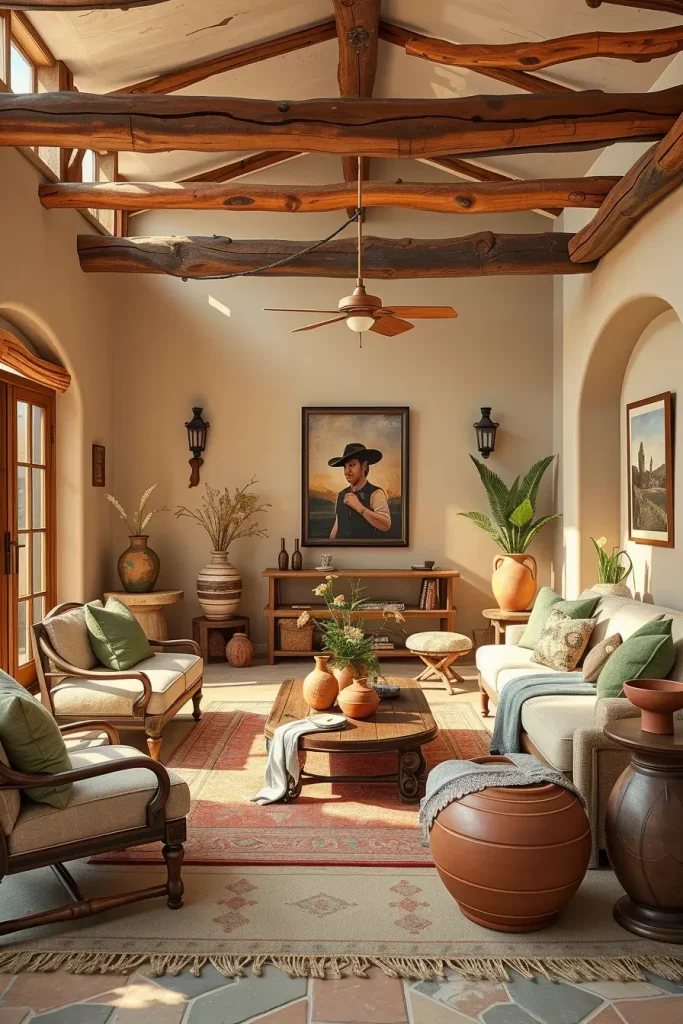
In my opinion, neutral means dull—neutral beige colors is where earth tones have depth and variation. Elle Decor states that “Warm neutrals are back and richer than ever,” confirming the palette range for the west. I love how these tones invoke history and harmony at the same time.
Adding hand-dyed curtains would elevate the section by visually enriching the area while artisan enrich the area.
Cowboy-Inspired Living Room Themes
The living room is the place where western home design comes to life. Cowboy-inspired themes don’t have to be tacky, they can be modern, well layered and deeply personal. Using leather mixed with plaid, and vintage ranch decor pieces evokes that open-range charm while modernizing the look.
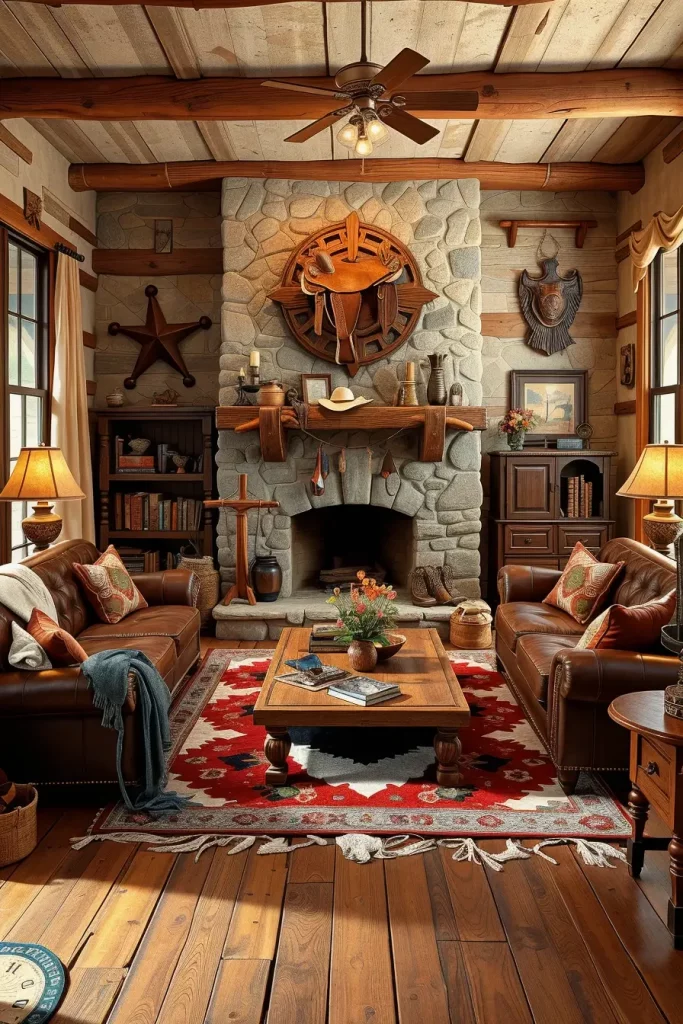
With a cowhide armchair or leather sectional anchoring the room, I add southwestern pattern rugs and metal coffee tables, while old horse saddles hang on the walls. The large stone fireplace is the natural focal point. Bring in natural light—This area needs large windows, minimally dressed, to let in ample sunlight. For added architectural drama, I like incorporating reclaimed barn beams on the ceiling.
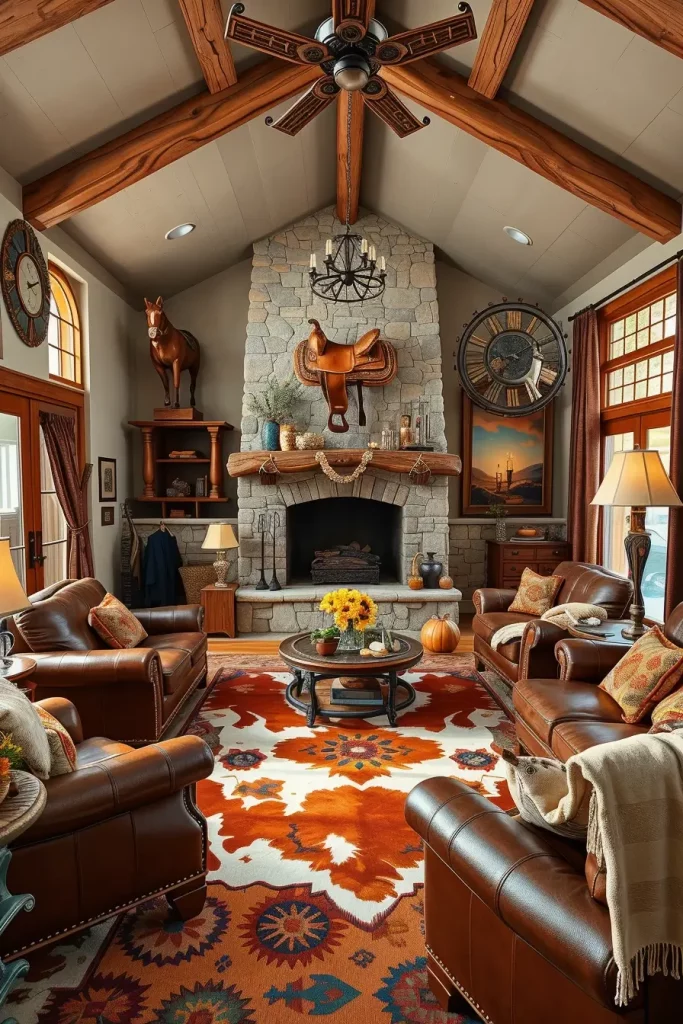
Personal effects such as cowboy boots, rope, and horse artwork add a unique character to the design. Southern Living suggests these western homes utilize “heirloom items” as decoration, which I find to be true. It enhances nostalgia and becomes uniquely you.
For added warmth, I recommend woven throws and rust-colored curtains to compliment the old saddle decor.
Using Western Wall Art and Prints: Decoration Ideas
Storytelling wall art is my go-to choice when I want to add depth and character to a rustic western home. Art captures the essence of the American West—be it a sepia photo of a dusty trail, a painting of untamed horses, or even vintage rodeo posters. These art pieces anchor a room together while adding a touch of rich cultural reference which any guest will recognize and appreciate.
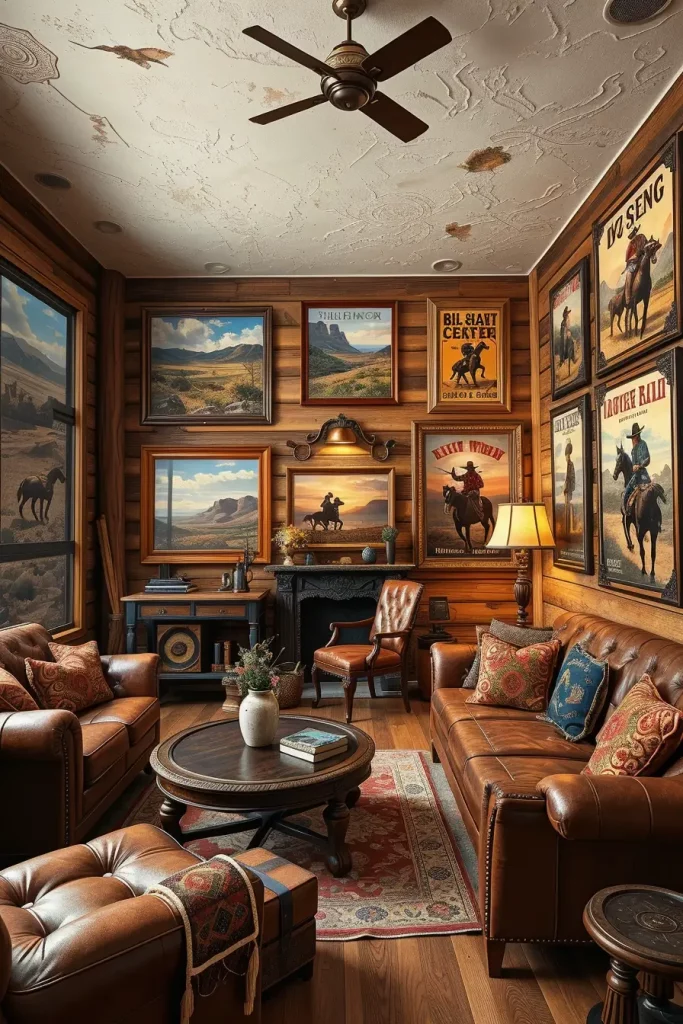
In my own practice, I often place large canvas prints of desert landscapes or black-and-white cowboy photography above the mantel or behind a sofa. I also love adding three-dimensional elements to artwork with metal wall sculptures, wooden signs with rustic style lettering, and even framed reclaimed barn windows. Such art always complements rugged furniture and warm design tones while firmly anchoring a space visually.
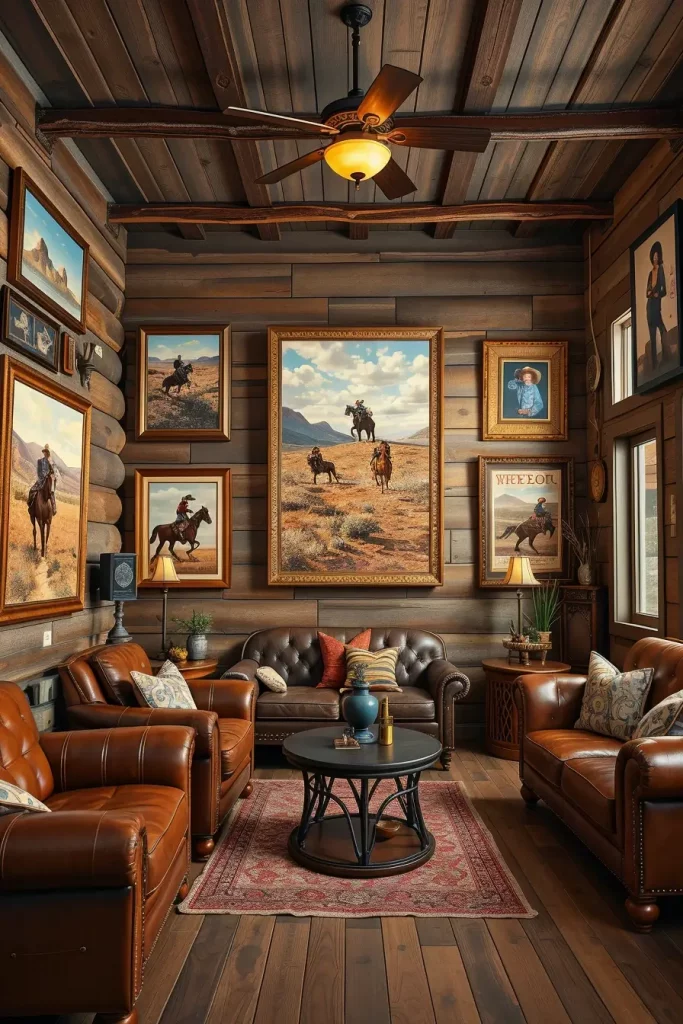
From working with clients, I have come to appreciate the thoughts many have about western spaces: the art should feel curated, but relaxed—not overstyed. As noted by House Beautiful, combining large print pieces and smaller hand-made art creates a more dynamic wall composition. I, too, wholeheartedly agree—with traditional western imagery and abstract earthy shapes.
As for this part, I would recommend implementing stratified gallery walls or woven textile hangings for more tactile variation in order to avoid blank wall spaces.
Adding Rugged Touches With Cowhide Rugs
In any western interior design, cowhide rugs remain as a staple. In my opinion, they are a must when trying to add an organic and grounded component to the room. Looking to the more modern industrial side, their unusable form helps to soften clean architectural lines while also warming up the space that has wooden floors or stone tiles. Whether you’re working with a modern ranch or cabin-style space, cowhide rugs literally scream ranch-style authenticity.
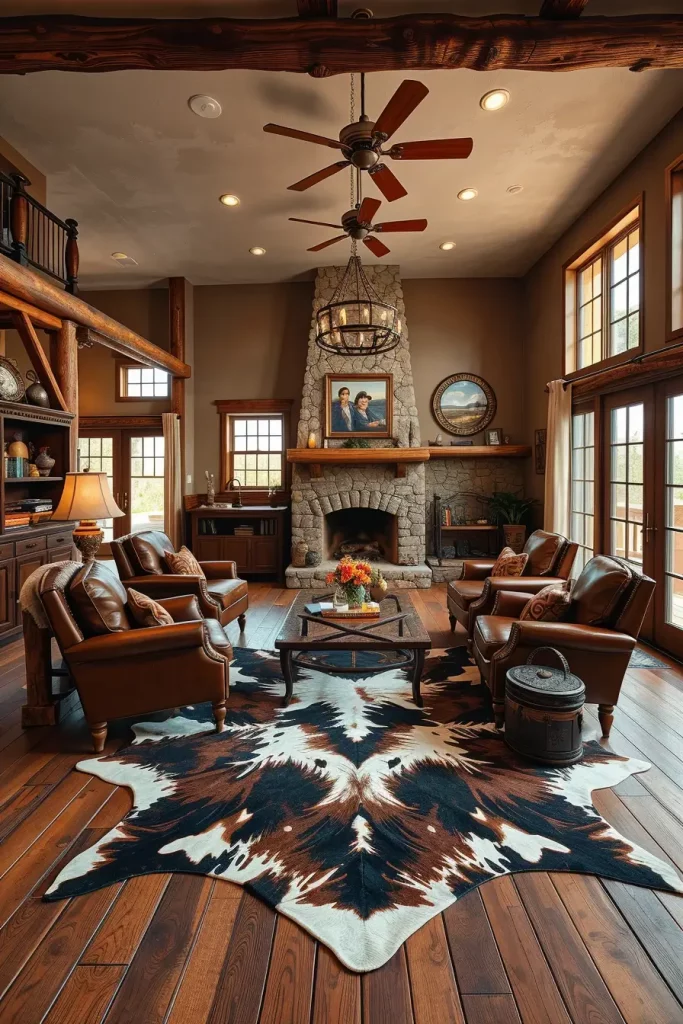
I like placing them under coffee tables or vividly by the fireplace and even under a bed to add an appealing mix of shapes and textures. The natural colors such as white, brown and black fit most western color schemes beautifully. Those pieces are not like traditional rugs, they are more long-lasting, simple to maintain, and hypoallergenic, combining decoration and practicality. I usually use those pieces with distressed leather seating and iron accent tables with no other intention than to sustain the overall feel.
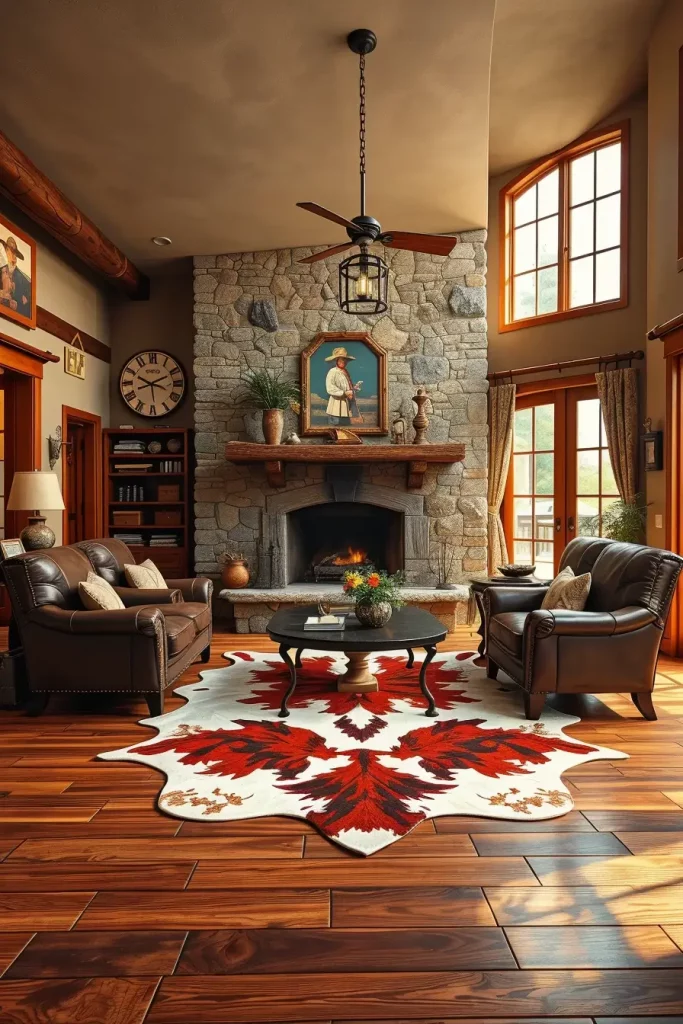
As a designer, I know that many clients don’t expect cowhide rugs to be as versatile as they can be. Country Living mentions cowhide rugs functioning wonderfully as layering pieces beneath jute or sisal rugs, which adds a room’s softness. I frequently apply this in entryways and dens.
To further complete this design theme, you might add cowhide ottomans, pillows, or even chairs upholstered in cowhide, creating balance and harmony to visually tie the area together.
Western Lighting Fixtures To Set The Mood
Lighting has the power to set the mood for any given space and in a rustic western home, it can make all the difference. In western rustic homes, the right fixture can change everything. I prefer to use lighting that seems to be hand forged and has weight—pieces that are constructive while still ruggedly beautiful. Picture wagon wheel or antler chandeliers, lantern style sconces, and lamps with iron or wood bases.
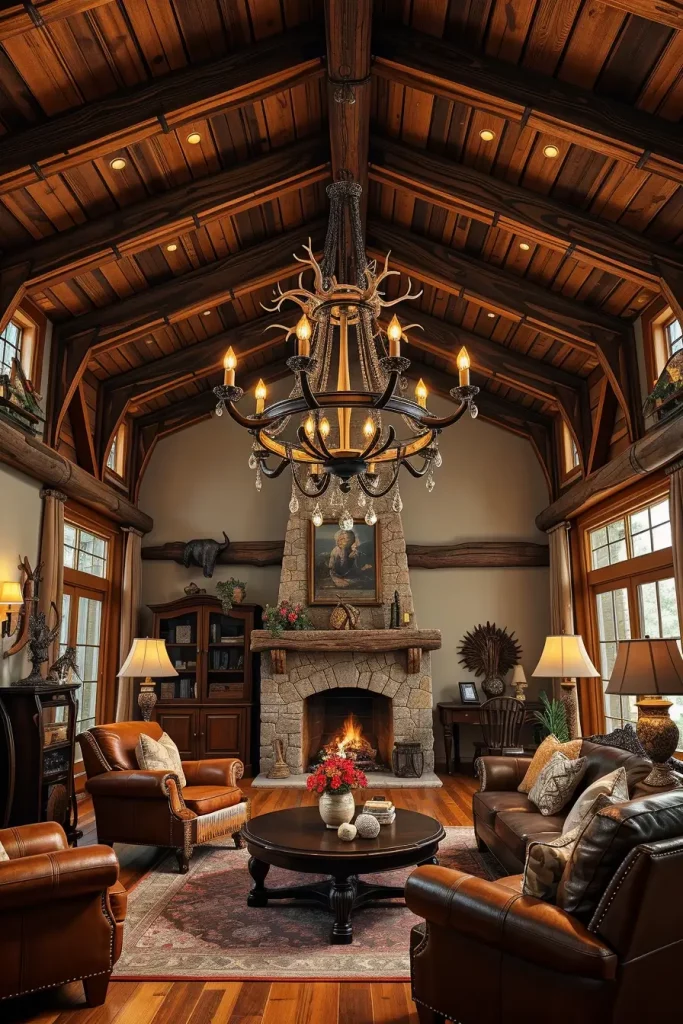
To enhance the historical appeal of a room, I regularly place an oversized wrought iron chandelier with Edison bulbs in the living room. For smaller spaces such as bathrooms or hallways, I choose rustic wall sconces or pendant lights with a weathered finish. These lighting designs work hand in hand towards unifying the interior style and achieving that warm amber hue which adds grounding and welcoming qualities to the room.
In my professional experience, lighting might be the most overlooked element in western rustic decor, but is incredibly transformative at the same time. As per various HGTV recommendations, layering lighting or combining ambient, task and overhead sources boosts overall function as well as set the mood. Personally, I recommend using dimmers to control how the space feels during different times, from events to simple gatherings.
Expanding this, you could suggest adding freestanding lamps from untreated natural wood or leather-wrapped base lanterns to enhance visual warmth and diversity.
Incorporating Iron And Metal Accents
Adding iron and metal accents in rustic western home decor helps to give structure and weight to a space. The warm wood and leather tones further enhance the contrast of an industrial edge. For these reasons, I try to use these materials because they also help to anchor the design visually. Additionally, metal elements can change the way light is reflected in a space, so they contribute to the subtle highlights throughout the room.
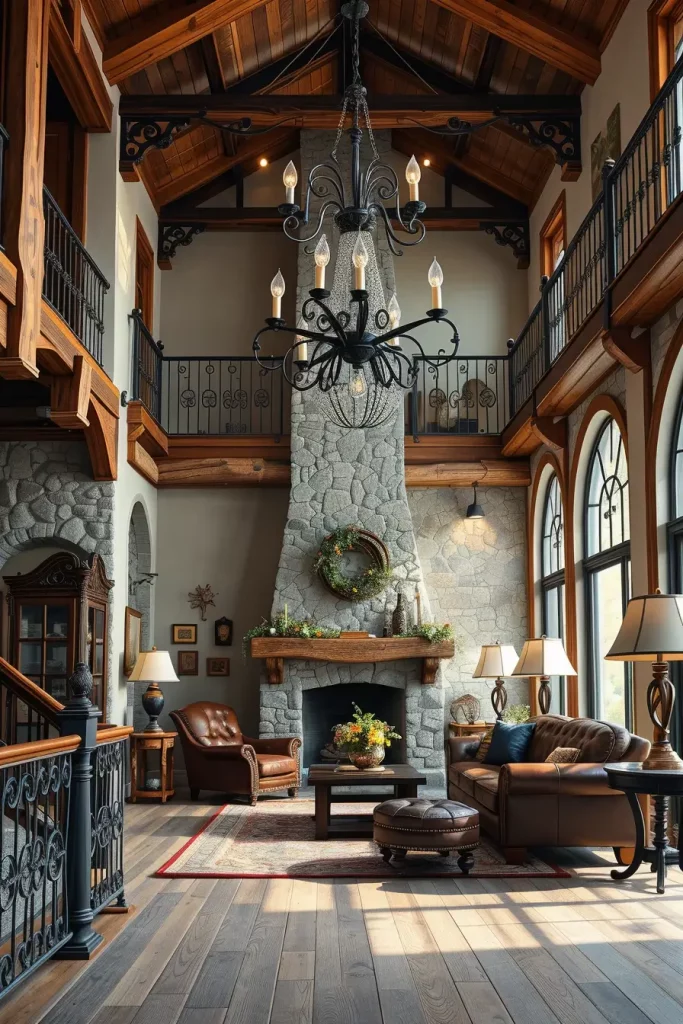
In my own projects, I enjoy adding touches I consider more bespoke like iron curtain rods, cabinet handles, stair railings, and furniture legs. Large wrought iron chandeliers and metal framed mirrors also add flair to the pieces. To add historical authenticity, I have worked with custom blacksmiths to design fireplace tools and door hardware. These touches, however small, enhance the look of the design as a whole, giving it strength and coherence.

History from ranch homes and historic lodges provides inspiration for the decor because iron was used not for its beauty, but for its strength; any enduring purpose adds beauty in modern decor. Southern Living has been quoted saying, “the combination of iron and steel with wood offers visual tension,” so it does enhance the dynamacy of the room. I find myself often combining my iron accessories with live edge tables and leather chairs.
As one last touch, I recommend including galvanised signage or branded shelves made of copper or tin framed metal to resonate across all spaces of the room.
Western Kitchen Decor Rustic Touch
When I design the western rustic style kitchen, it entails blending practicality with historical accents. I begin with the reclaimed wood cabinets, the stone or concrete worktops, alongside vintage wrought iron fixtures which provide warmth and utility. The intent is to create an atmosphere that projects a sense of being cherished over time.
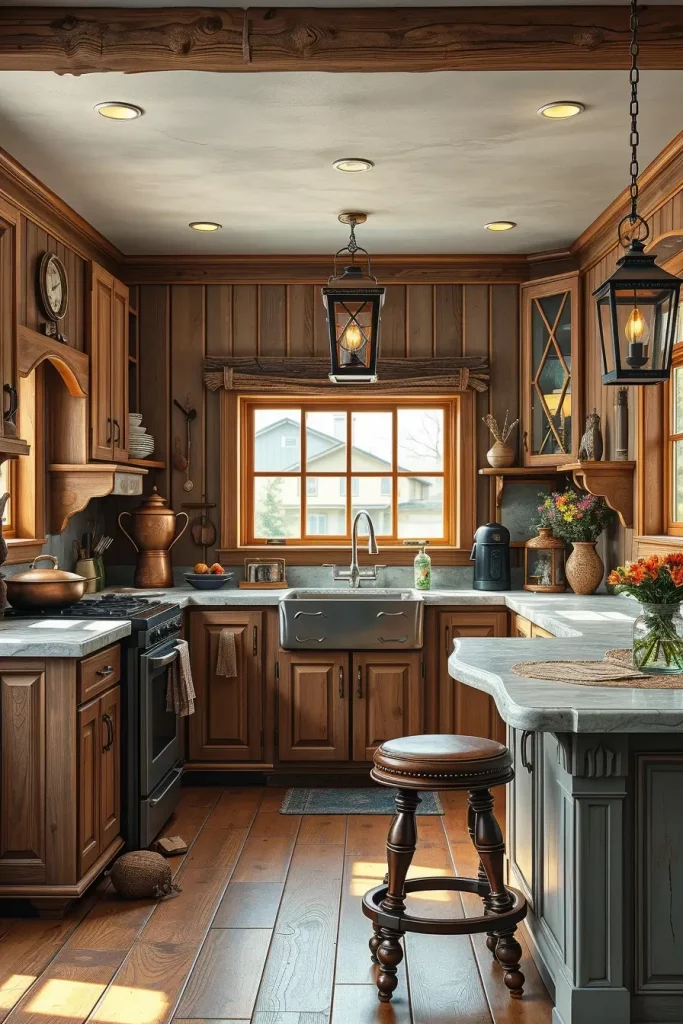
For best results, I personally like to use shelves as raw wood planks like the beams, PEX overhead lights which are made of old Mason jars or lanterns, and pendant lights over the island. Complementary to the design, the warm terracotta tiles or patterned rugs give a rustic soft appeal. The space and furniture should be relaxed yet inviting.The set up needs to be spacious yet clutter-free.
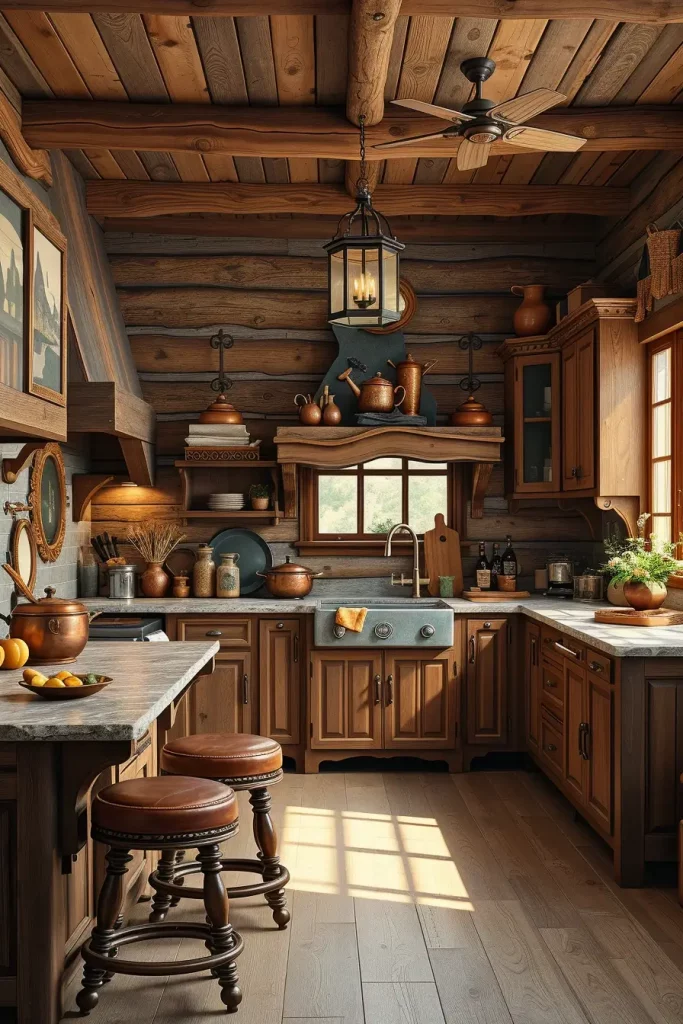
Personally, rustic western kitchens feel like the heart of the home—and where my family and I gather. I read somewhere that modern ranch houses are adopting this style to keep their spaces warm yet functional. As Better Homes and Gardens puts it, rustic kitchens are charming because of the balance they strike between beauty and simplicity.
You can complete this design by incorporating woven baskets, rustic spice racks, vintage signage, or other whimisical touches to soften the space.
Rustic Dining Areas With Farmhouse Charm
The feel of rustic western dining spaces should be warm, inviting, and timeless, yet connected to the land. I always start with a solid wooden dining table, typically an item from my collection of weathered, reclaimed, or custom-built furniture. This is the centerpiece, and I design the rest of the space around it. The dining area perfectly showcases the more rugged western decor styled with heritage touches, warm textures, and family friendly appeal.
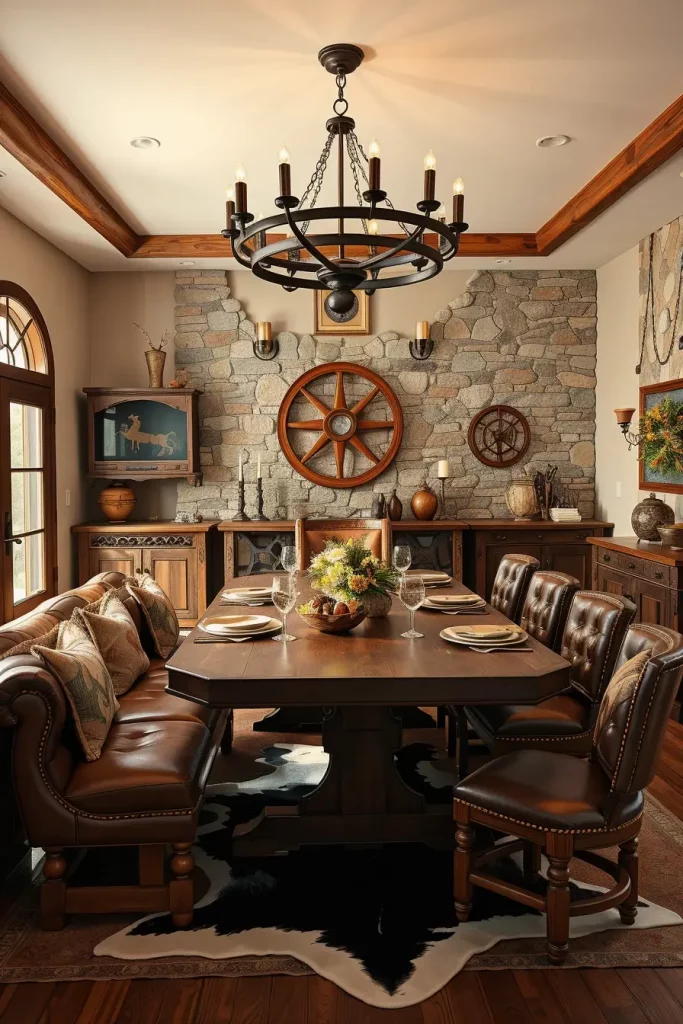
For seating, I have an assortment of wooden chairs, leather-upholstered benches, and even cowhide-topped stools. Overhead lighting often includes a large wagon-wheel chandelier or a rustic beam light fixture. As a rule, I always create a centerpiece using nature’s gifts, such as dried flowers arranged in a ceramic vase or antlers placed on a wood tray. The stone accent wall along with layered rugs and exposed beams helps finalize the look.
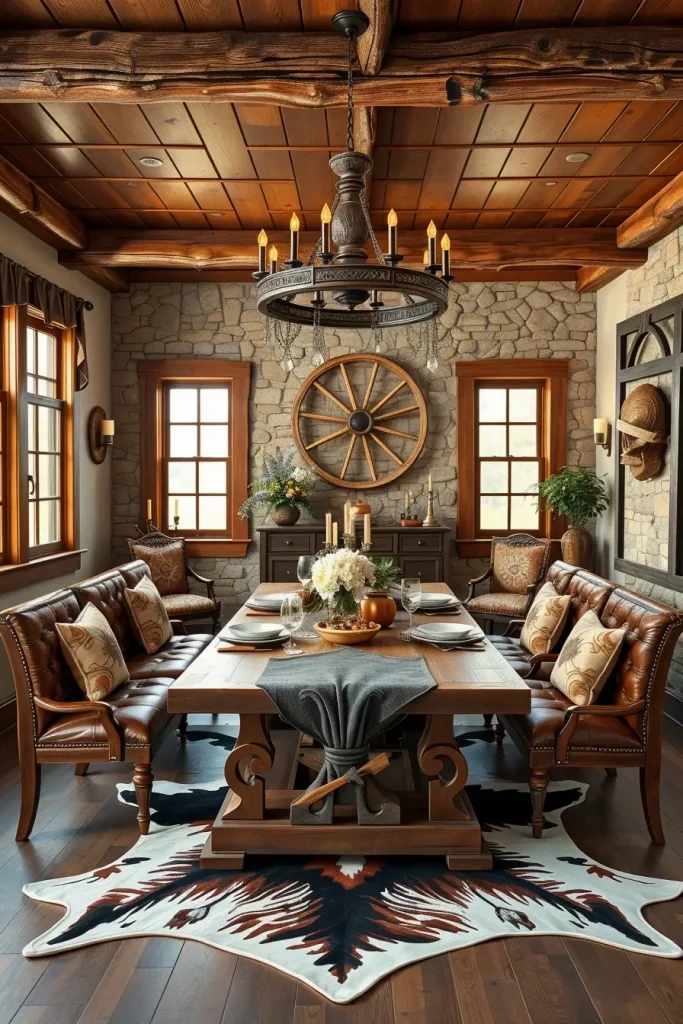
One strategy I like to employ is softening the heavy wood tones with warm textiles such as plaid or linen napkins, wool throws, and Navajo-print seat cushions. I remember seeing a feature in Farmhouse Style Magazine where they decorated the wall above the dining table with a saddle, and it has stayed with me ever since.
To finish this off, I’d include hutch or open shelf vintage dinner wares, iron candle holders, and rustic pottery on display.
Western Bedrooms With Barn Inspired Features
This is the one area where rustic western decor can be calming – the bedroom. Focused on comfort, natural materials, and textures that promote rest. Details such as sliding barn doors, reclaimed wood walls, or exposed beams are instantly characterizing the room. When combined with cozy layers, it transforms into a rugged yet restful retreat.
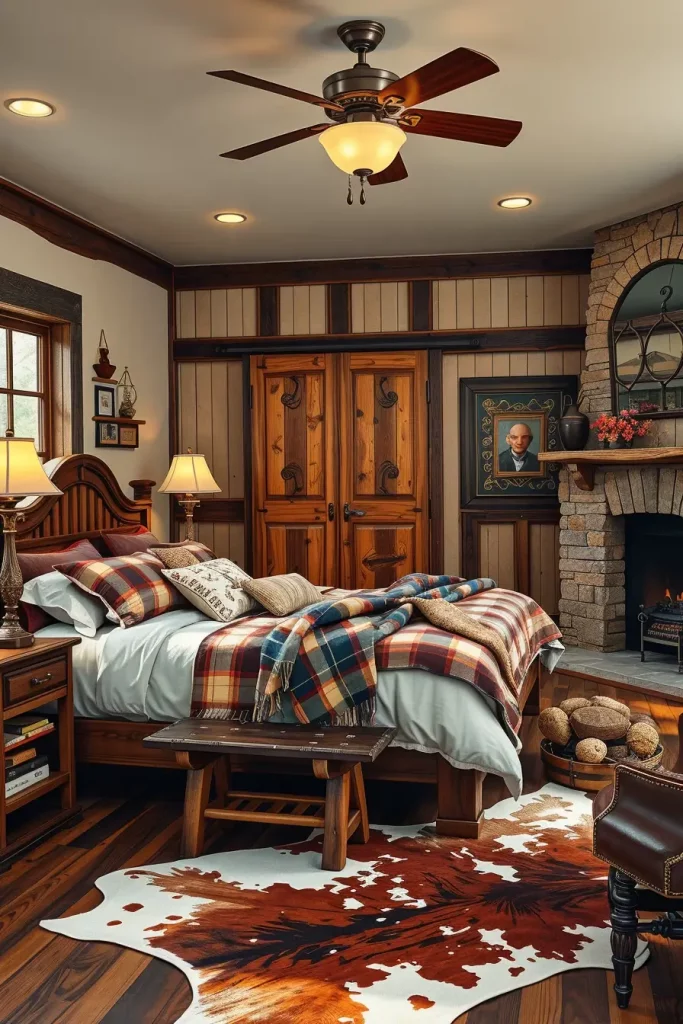
Most of my western style bedrooms feature a large wooden bed frame which usually has a distressed or carved headboard. The rest of the room is built around it. The quilted blankets, woven throws, and flannel or linen sheets helps achieve a more ‘lived-in’ aesthetic. I like to complete the look with vintage trunks or benches placed at the foot of the bed, paired with iron bedside lamps, and western themed wall art that helps give the room more character.
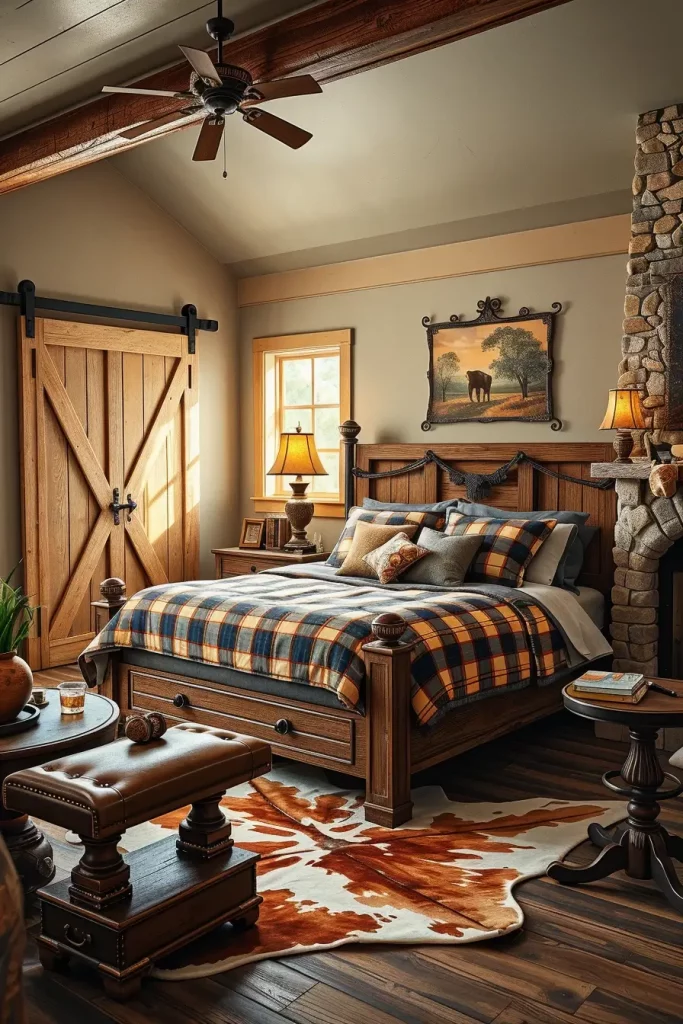
From my experiences, western style bedrooms offer a great opportunity to showcase one’s personal history. Family heirlooms, an old cowboy hat, or even boots used as decor can have a lot of meaning. Architectural Digest recommends using nostalgia as a visual reference in more rustic bedrooms, a design choice that I appreciate.
For enhanced warmth and more visual appeal, pair the previously mentioned western style decor with leather accent pillows, barnwood night stands, or even a cowhide rug under the bed.
Browse The Best Rustic Western Styled Bathrooms
Personally, rustic western bathrooms provide warmth and comforting relaxation to a wooden and distressed space aged with time. The primary idea focuses on natural elements combined with western vintage pieces that include hammered copper sinks, rugged vanities, and distressed wood. An old-world bathhouse or lodge and its idiosyncratic design evoke deep and warm feelings. That’s what I aim for.
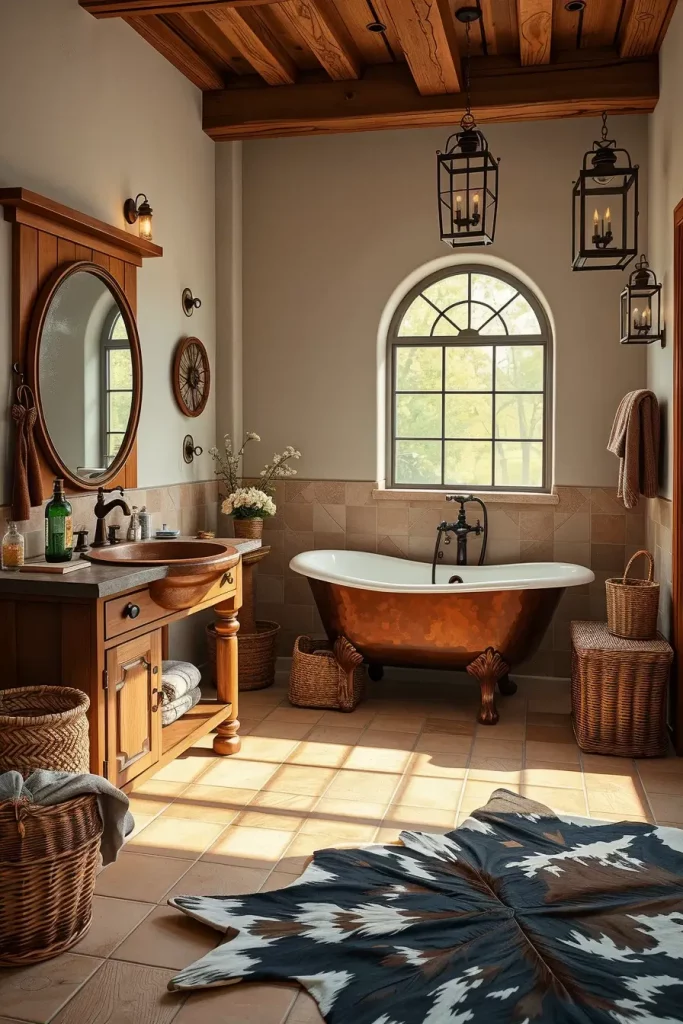
Rustic western bathroom design begins with reclaimed wood, which adds warmth to the texture and is perfect for the vanity or accent wall. An authentic touch can be paired with a freestanding clawfoot tub with iron hardware. Lighting is just as important; antique lanterns provide rustic tones while warm lights set the mood. Mirrors, baskets, and western textiles add character to the already stunning room.
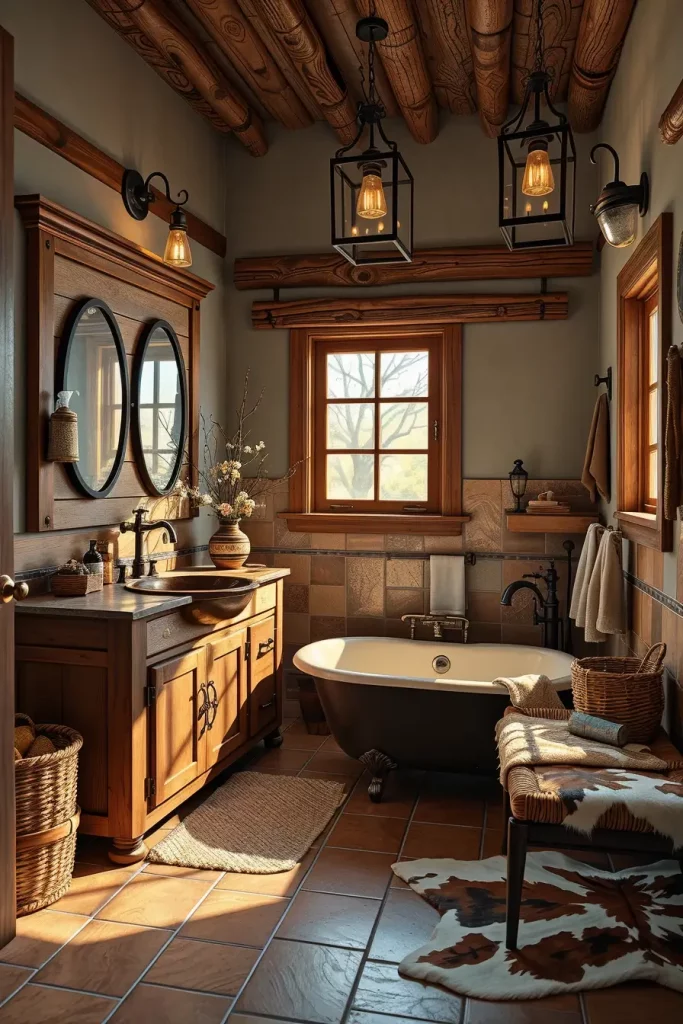
With western textiles and rustic charms, the warm bathroom can be understated, as shown in the HGTV suggested designs. The inclusion of tiny details such as horseshoe towel hooks is delightful. The theme of earth tones is good to follow; deep greens, sand, and terra cotta is perfect to follow the cohesion set forth. Striking a balance between modern convenience and old-world enchanting feels, as suggested, really helps the look.
I recommend adding a cowhide or leather bench for seating, and perhaps a rustic shelf for décor or functional shelf that is visually appealing and matches the style.
How To Use Antlers And Horns In Decor
Probably the most iconic feature of rustic Western decor is the use of antlers and horns. They are not merely decorative accessories; they represent an outdoors and frontier heritage. I use these features as vertical design elements to bring up scale and character into a space like living rooms, dining rooms, and corridors.
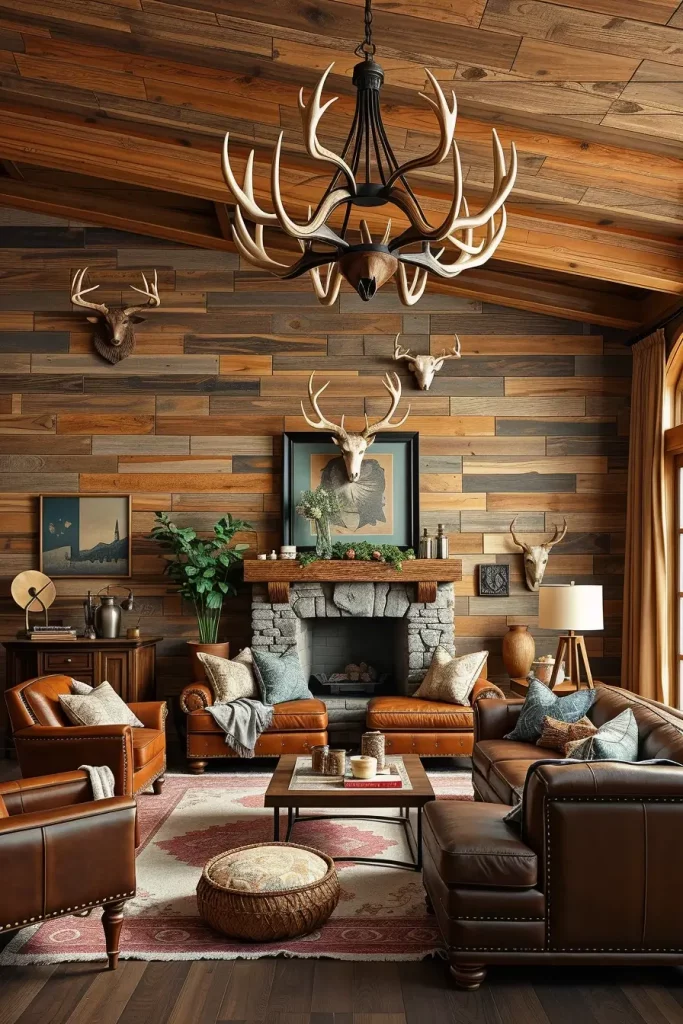
I often put up a large antler chandelier in an entrance hall or above a dining table. Antler candle holders or picture frames with horn inlays are great for more subtle decor. Over a stone chimney, mounted antlers create a wild rustic focal point. Such pieces are wonderful set among reclaimed timber and well worn leather furniture.
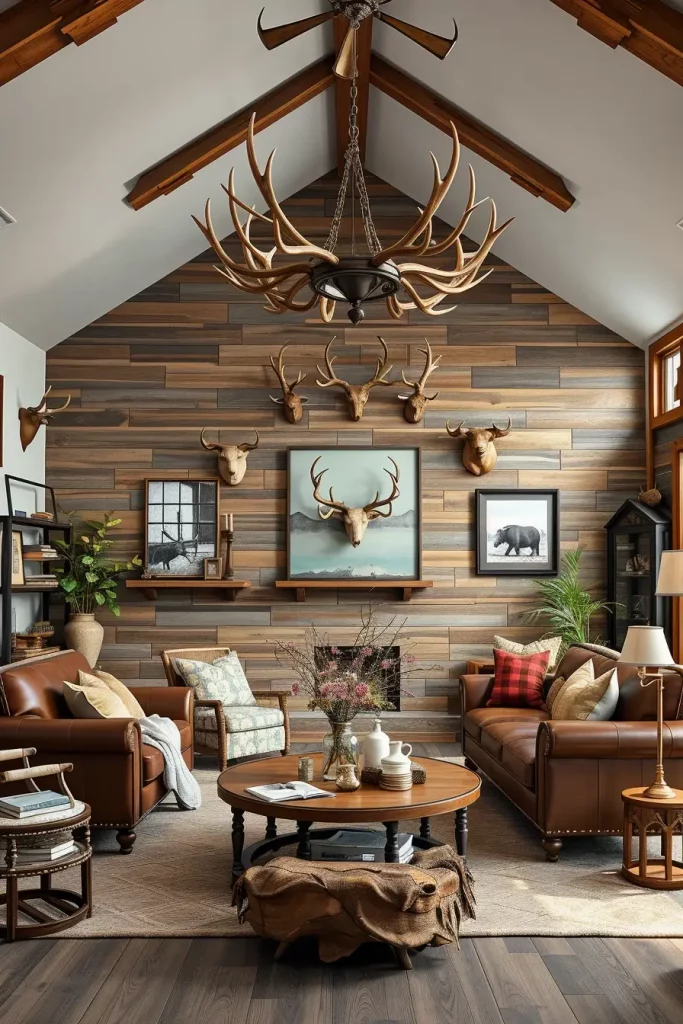
In my home, I mounted a pair of faux antlers above my mantelpiece, and I have to say, they were beautifully designed, and so ethically sourced. Inspiration from Elle Decor recommended these elements should be included, but used with caution as they could look overly unthemed intended, and I completely agree. With such bold features, less is truly more.
To elevate this part, I would also incorporate horn elements such as mirror frame or drawer pull to subtly introduce the theme’s focus.
Designing A Ranch Entryway
A ranch entryway gives a feeling of an attitude toward nature and family. I consider it a sort of a welcome mat that hints ‘rambling comfort’ at first sight. The design needs to be practical, thematic, and multifunctional which means it should mix rustic materials with practical items like hooks, benches, and appropriate storage.
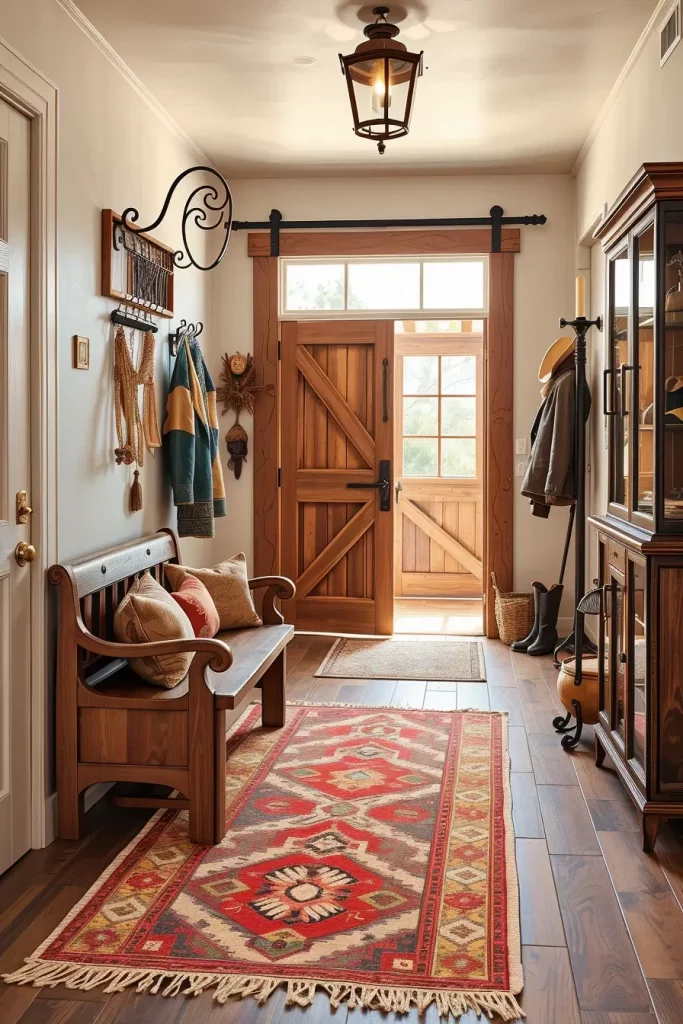
I work from the base which includes a weathered barn wood bench, wrought iron coat rack, vintage western signage or artwork, and sometimes, but not limited to, barn doors or rough-hewn wood trim. To create a rustic western feel, adding a saddle or cowboy hat is effective. Galvanized metal boot trays are aesthetically pleasing and also serve a purpose.

Personally, I like to add western textiles accents such as a Navajo rug runner or cowhide bench throw. Country Living suggests the best kind of entryways are those that blend charm and convenience. That’s why I really appreciate their insight. This space will be the first and the last one visitors interact with so it’s important for it to feel true and authentic.
A console with rustic charm and storage along with a lamp would also come in handy for lighting the area at night, which would be ideal for setting keys.
Western Styled Fireplace Designs
It’s often said that the western-style fireplace serves as the focal point of the fireplace’s western furniture style room, and I love to center it with a heavy rustic stone or adobe plaster. The timber mantel pulls everything together beautifully. The fireplace can also add character to the space when lightly balanced with a rough beam barn timber.
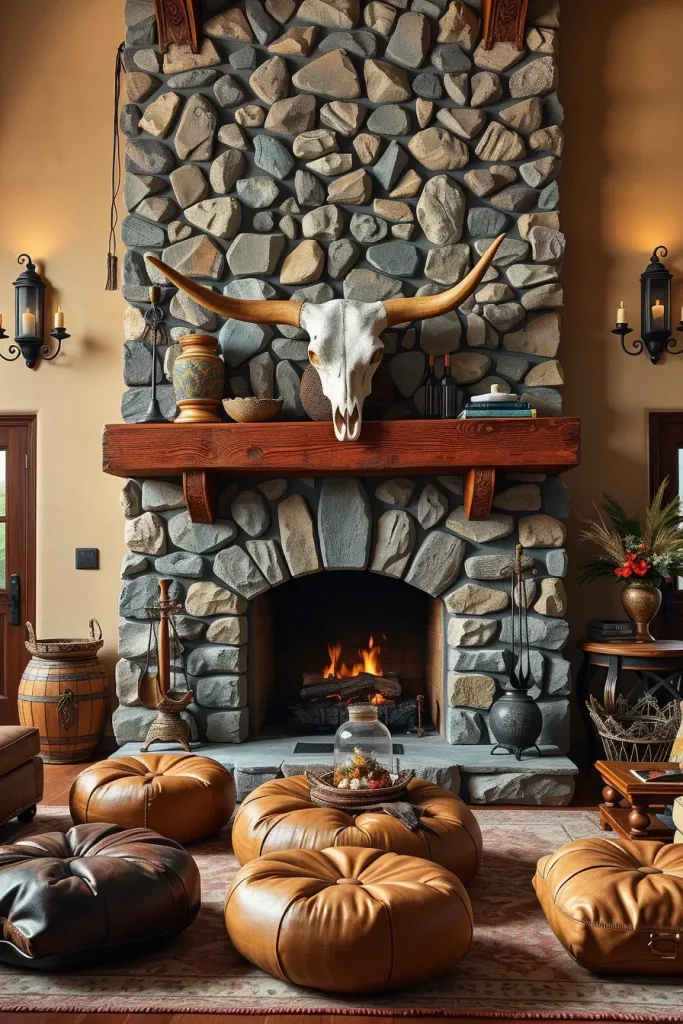
Mounted longhorn skulls and rustic iron sconces also pair beautifully with the mantel. The hearth space can be dressed up with stacked wood, leather poufs for seating, old branding irons, or good old branding irons. Surrounding the fireplace, I find aged metals, stone, and distressed woods particularly filling to the warm country feel alongside their sharp contrasts.
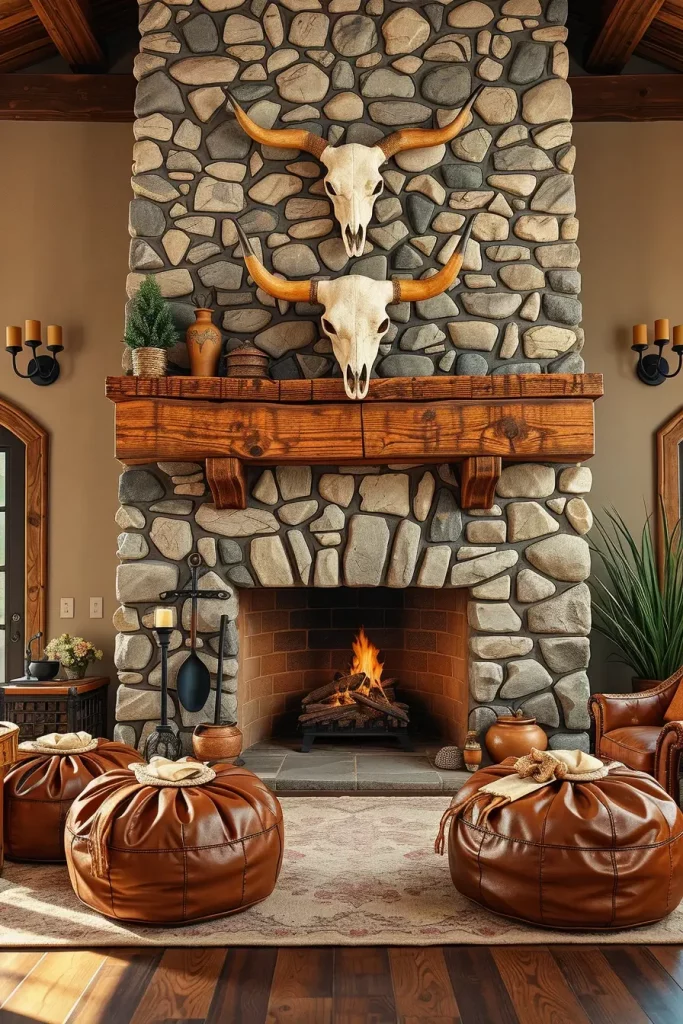
My living room features an equally stunning sandstone surround sitting beside an expansive landscape painting hanging above the mantel. To add authenticity, I feel using handcrafted elements such as pottery and ironwork, as suggested by Better Homes & Gardens, to the space is crucial.
To enhance the design even further, I would use reclaimed wood beams as a centerpiece above the fireplace, in addition to fire tools with wrought iron handles, and I would elevate the design even further.
The Character of Vintage Western Accessories
No rustic western home decor is fully complete without vintage western accessories pieces, which have historically been infused within the furniture. Personally, I put a lot of effort into finding items at estate sales or antique markets like boots, lanterns, saddles, or even spurs. I believe these pieces add true character to the room.
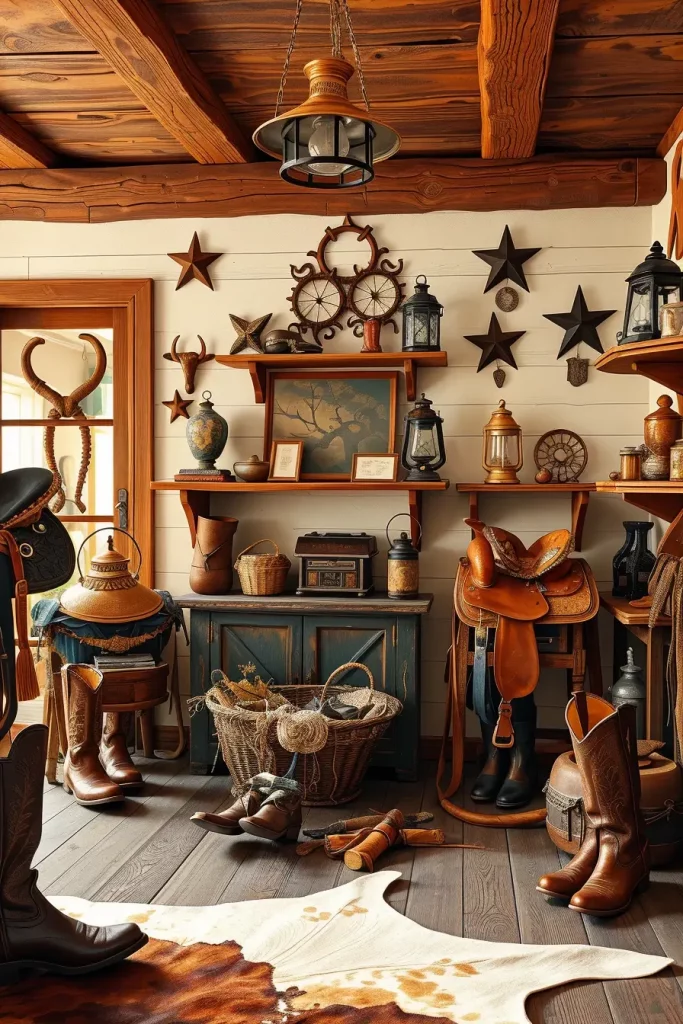
I do not solely use these as decorative pieces; I rather style them into vignettes, like a cowboy hat hanging on a hook or an old lasso placed perfectly across the wall. Horseshoe wall décor makes the surroundings feel more authentic, while vintage crates serve as charming side tables.
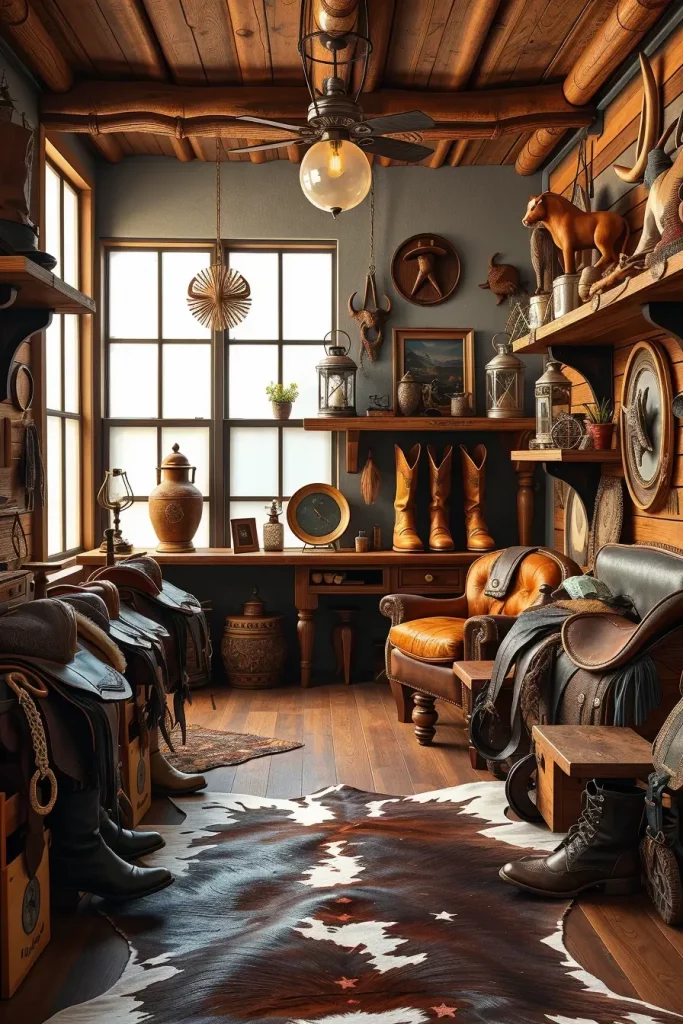
It aids in unifying the space when these pieces are skilfully chosen, and not layering them too deeply. I tend to agree with Architectural Digest that cluttering a room with too much decor turns the setting into a museum, and suggest including modern pieces to lift the overall aesthetic. Less is more if the accents are chosen correctly.
A display cabinet or shelf would assist in prominently showcasing those pieces without overdoing the warfare of structure. The rest of the room would breathe.
Western Inspired Textile Decor
Using southwestern motifs or Native American patterns has always been my favorite when it comes to western themed textiles as I make use of natural fabrics. Not only do these décor pieces bring warmth into the room, but the deep brown, turquoise, and earthy red hues surrounding the room offer a comforting feeling.
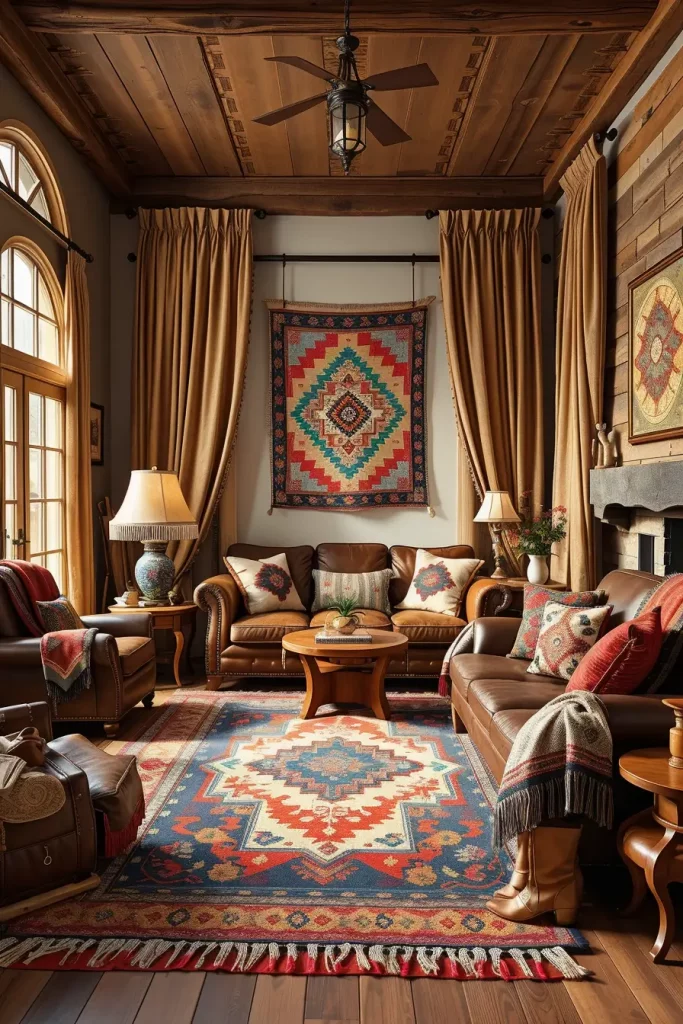
I throw Navajo woven rugs on the hardwood floors and leather blankets on the sofas, and further accent the warm leather furniture by draping western-inspired pillows on the beds and chairs. Large drapes with fringe or leather detailing look stunning in the bedrooms and livings rooms. My favorite decor pieces are Pendleton throws—they are very pretty and serve a practical purpose.
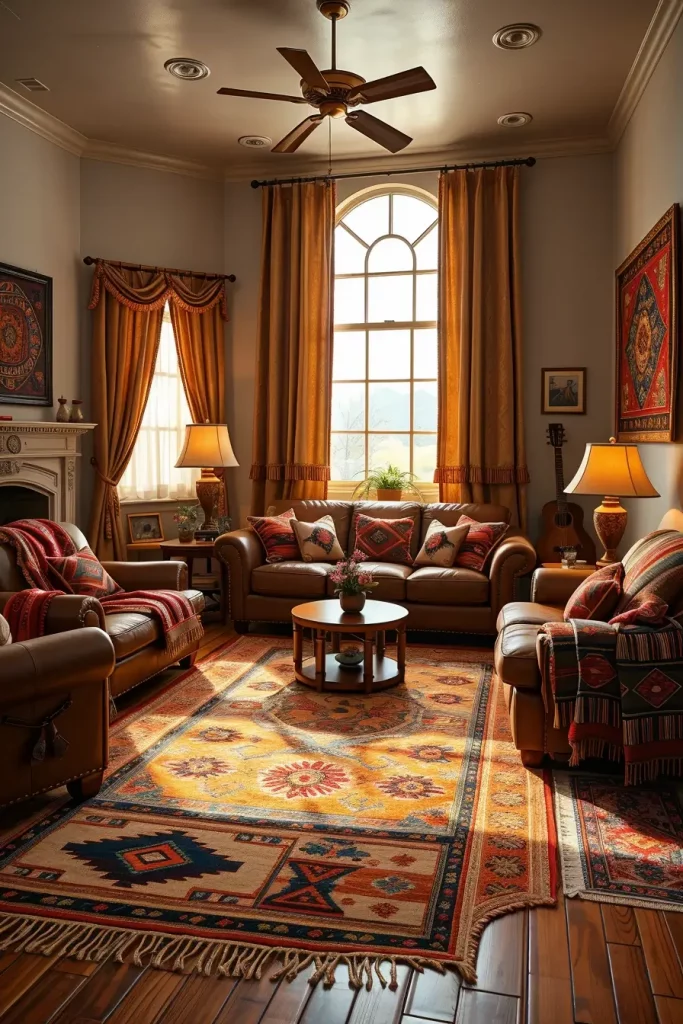
An all-time favorite of mine is a combination of canvas and denim and leather all in one space. Western Home Journal states that to add a western touch without going overboard, incorporating different textures is the way to go – and I’ve found that layering works especially well in colder seasons.
To round off this section, I would add a quilt or a woven wall tapestry for a bold addition of vertical interest.
Using Reclaimed Wood In Western Spaces
There’s no better way to ground a western space than by using reclaimed wood. I frequently use reclaimed wood for the walls, beams, floors or even for the built-in furniture because it is both eco-friendly and stylish. The wood’s texture and weathering adds character that new materials simply can’t replicate.
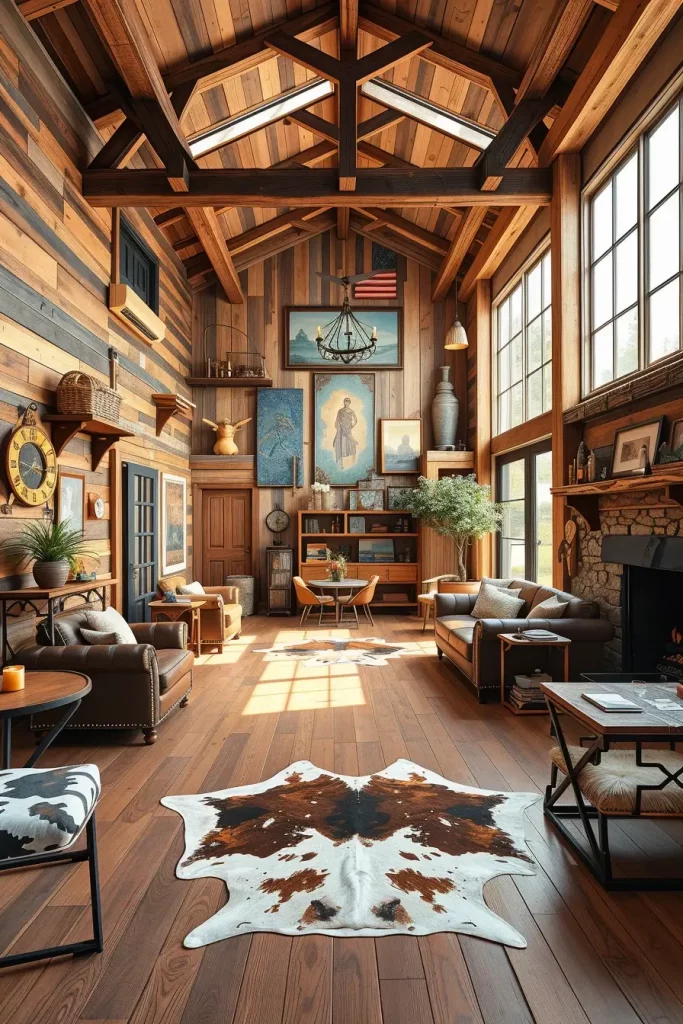
In my interior designs, I often add barnwood accent walls or install reclaimed oak floors. I also use old timber for shelving and exposed beams; these parts complement rustic western furniture, such as cowhide upholstered chairs, iron framed tables, and even a rustic wood headboard which transforms the room instantly.
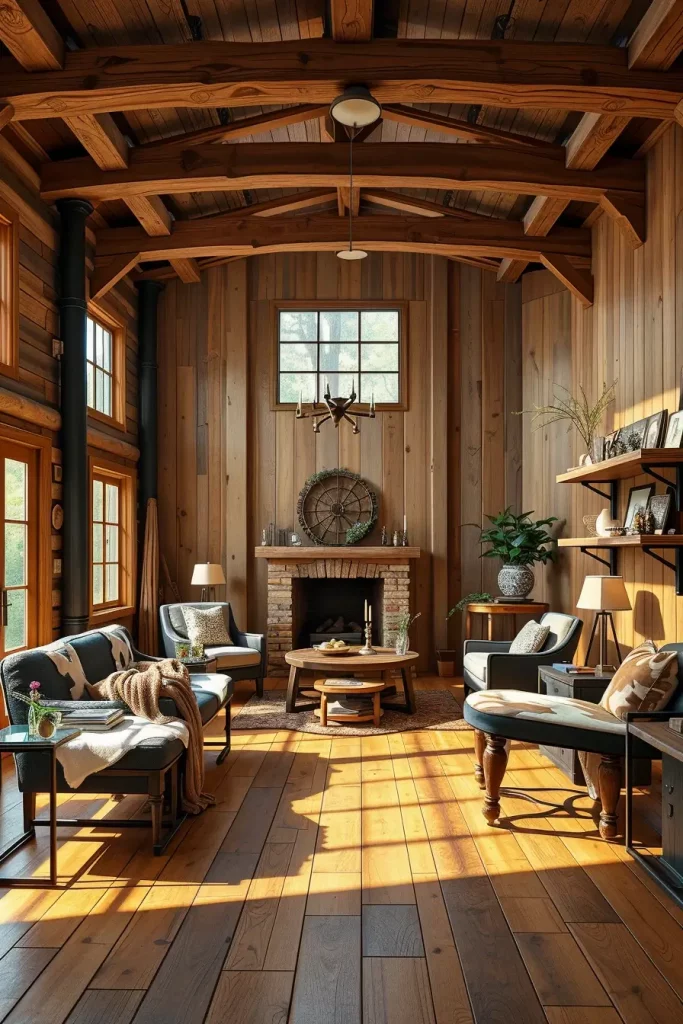
I’ve worked with some contractors that get reclaimed wood from old barns and it is beautiful. Interior designers like Joanna Gaines have remarked on the warmth and character reclaimed wood adds to a home, and I completely concur.
In my suggestions, I would propose small reclaimed pieces such as frames, boxes, or lamp bases to help tie the look together without needing structural adjustments.
Horse And Rodeo Themes In Rustic Decor
Decorating a rustic space with horses and rodeos showcases Western culture beautifully. When I work with these ideas, I concentrate more on equestrian accents that are artistic and lived-in rather than kitschy. This works wonderfully in socializing areas such as living rooms, bedrooms, or even game rooms. You can express the theme discreetly via wall art, or boldly using statement furniture and accessories.

Some decor elements I love to use are vintage rodeo posters, bronze horse sculptures, or Western embossed leather chairs. Additionally, I’ve designed with saddle stools for bar height counters and curtains tied back with ropes. A striking focal point could be a mural or large canvas wild mustangs. Some more subtle additions could be lasso lights, or stirrups used as cabinet handles.
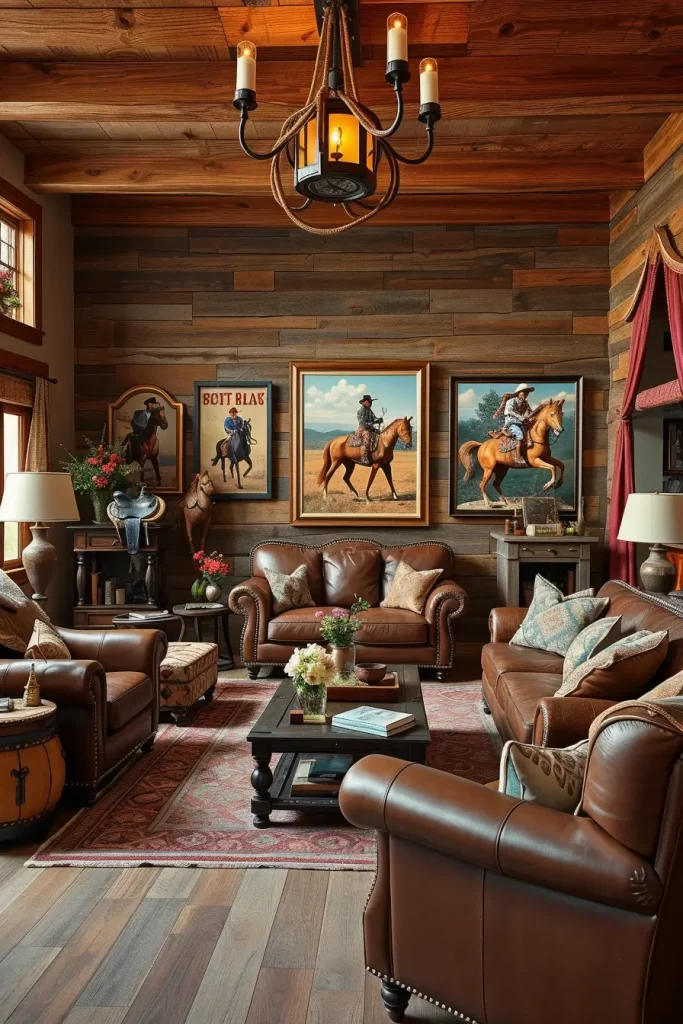
Another time, I designed a den and incorporated an old saddle decorative rack which I paired with suede textiles and horse cushions. As Better Homes & Gardens states, Western themes do not need to be literal; they can be executed through carefully chosen textures, silhouettes, and materials.
Incorporating barn-style sliding doors engraved with horse designs or perhaps curating a gallery wall of black-and-white rodeo pictures would elevate this design.
Outdoor Western Decor For Decks And Outdoor Sitting Areas
Taking the Western appeal outdoors instantly transforms the look and feel of the patio or porch and makes it appear warmer and more inviting. I treat these spaces as outdoor living rooms, so they need to be presented comfortably and with the right textures. Indoor themes need to be echoed to soften the stone, iron, and wood, which are the essential natural elements used to achieve comfort and texture.
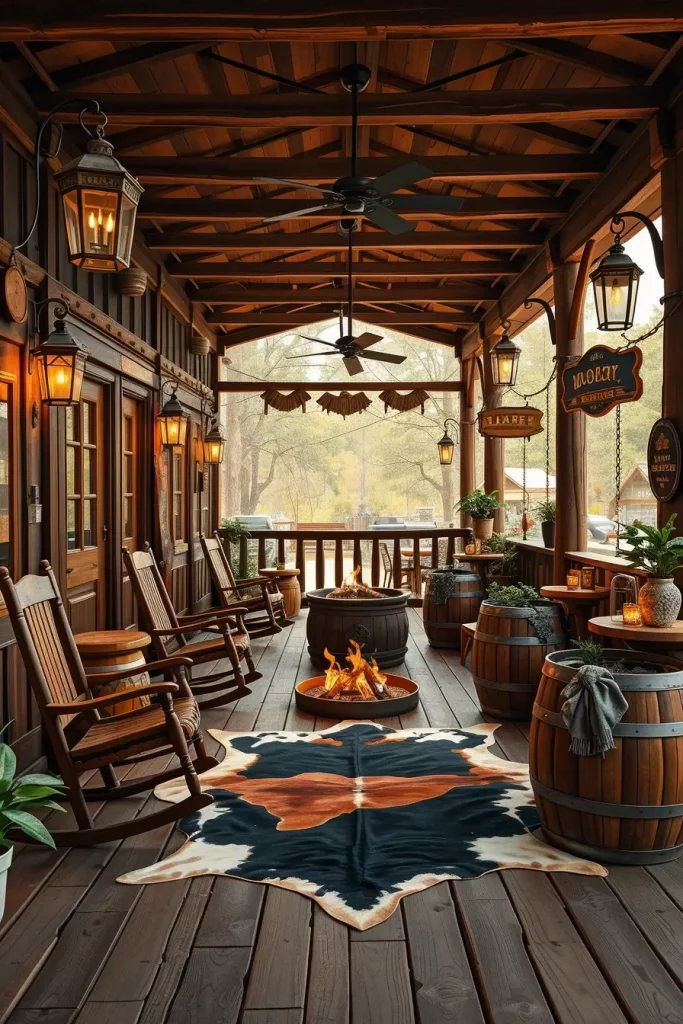
A solid foundation of wooden decking or stone pavers is where I like to start. Add to that, sturdy wooden rocking chairs or a reclaimed bench with leather cushions, which are ever so effortlessly, comfortable. But those are not the only seating options, as a cowhide rug perfectly ties the setup even outdoors. Moreover, iron lanterns, vintage signs, and a fire pit are essential touches. Wool blankets, woven baskets, and galvanized planters as accessories also help tidy the patio.
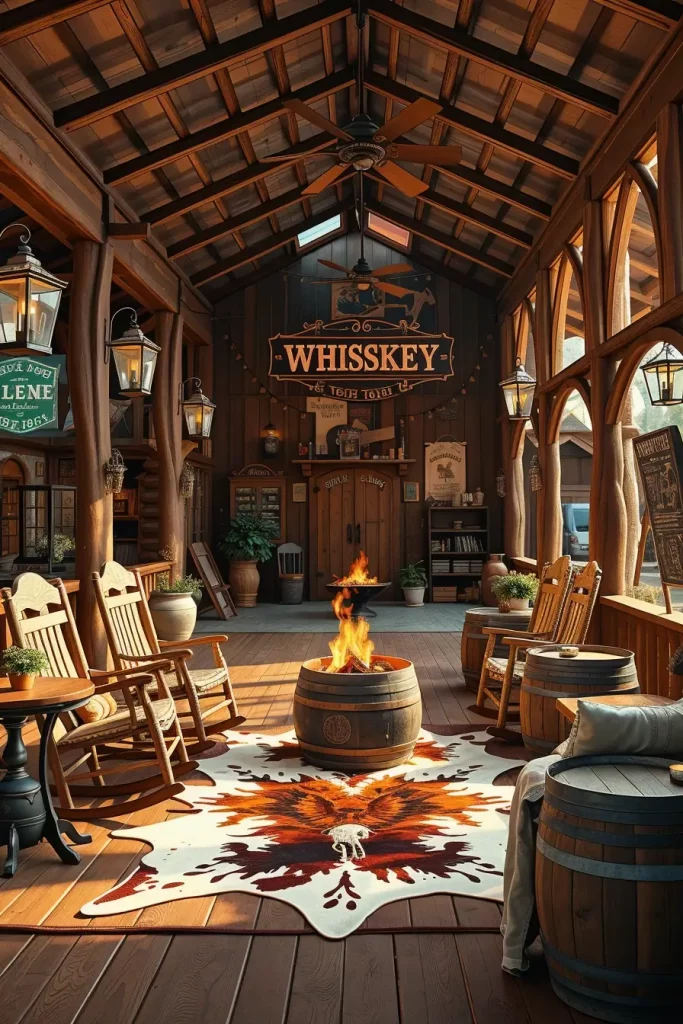
Personally, I’ve styled patios with repurposed whiskey barrels for side tables and wagon wheels as wall décor. I myself love the Southern Living idea of using authentic handmade pieces as weather-resistant furniture because they suggest function should never sacrifice style.
To enhance this area further, I would recommend placing warm, low-hanging bulb string lights or draping textiles on poles fashioned as a rustic pergola as shade and mood.
Designing A Western Styled Garden Landscape
A western garden landscape is inspired by the vegetation of the desert and open ranges interspersed with rocky features. My focus for these outdoor designs tend to be drought resistant plants as well as rugged driveways and tactile materials such as gravel, wood, and natural stone. The objective is to create ranch-like atmospheres while allowing for low maintenance landscaping.
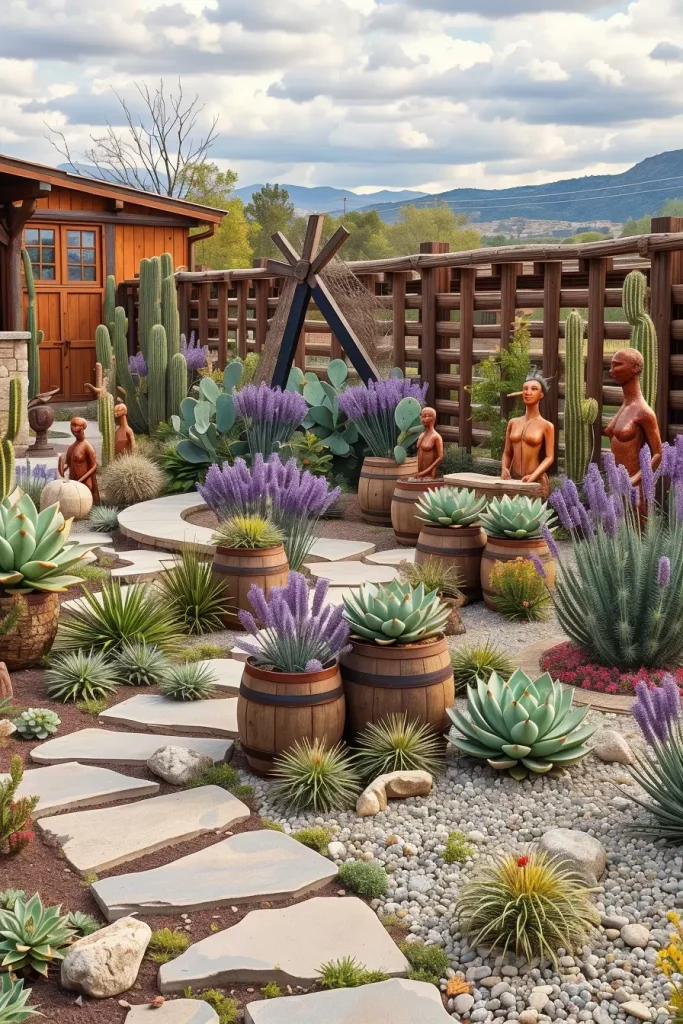
My goes to is sagebrush, blue grama grass, succulents, or flowering cactus. For the pathways, my first choice would be stone slabs or decomposed granite. Other decorative pieces include planter metal troughs, rusted sculptures, and a wooden split-rail fence. You can also incorporate charm with functionality using a rock lined fire pit or a water trough fountain.
One time, I created a garden path with horse hitching posts at the entrance and whiskey barrels overflowing with lavender. To quote Garden Design: “to achieve true Western landscaping, combining hardscaping with native plants is the primary element”. This is a principle I willingly endorse.
If I were to improve this setup, I’d have a shaded seating zone complete with a wooden arbor and maybe even a rustic garden seat crafted from salvaged wood so that I would be able to savor the full western feel.
Western Home Office Design Ideas
Having a home office in Western style can be a source of motivation, and it wraps you in a cozy rustic atmosphere. I personally think about them as masculine studies or creative dens where rich woods, antiques, and bold textures dominate – and like everything else there, these spaces feature rich wood, antique accents, and bold textures. The goal is a tailored yet personal space that still has some touches of the western theme.
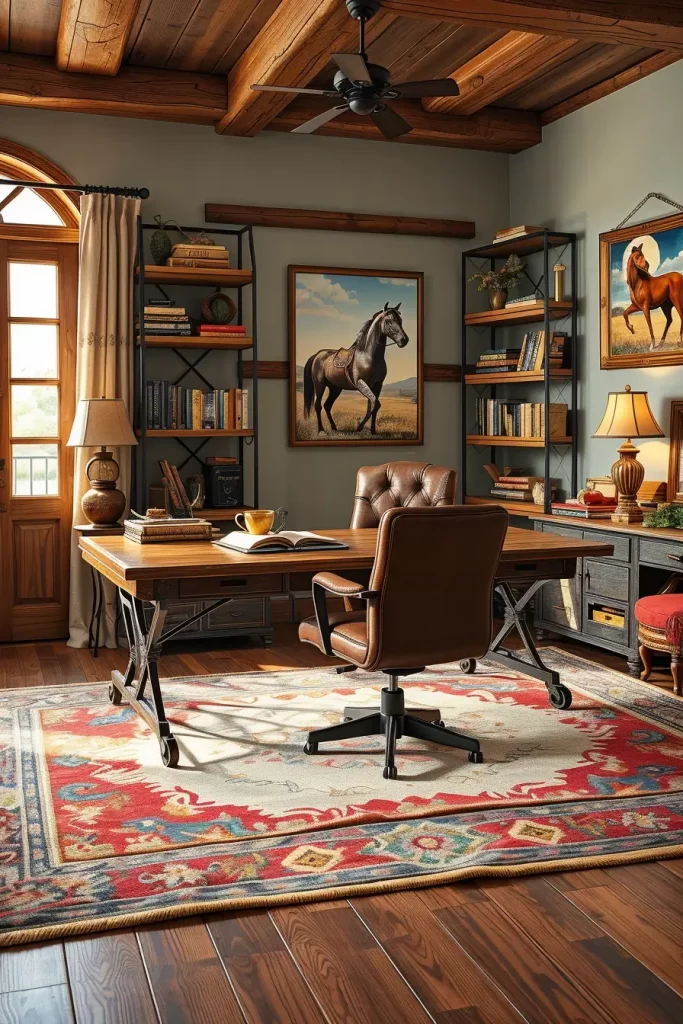
A large solid wooden desk, ideally reclaimed or distressed, is something I usually go for, paired with an area rug southwestern patterned to add warmth. For seating, I opt for a leather or suede swivel chair. These barnwood and iron bookshelves serve a dual purpose as storage and add visually interesting character. Over the wall, I like to embellish with framed maps, horse-themed art, or even some cowboy memorabilia. Personality can be found in these pieces as well.
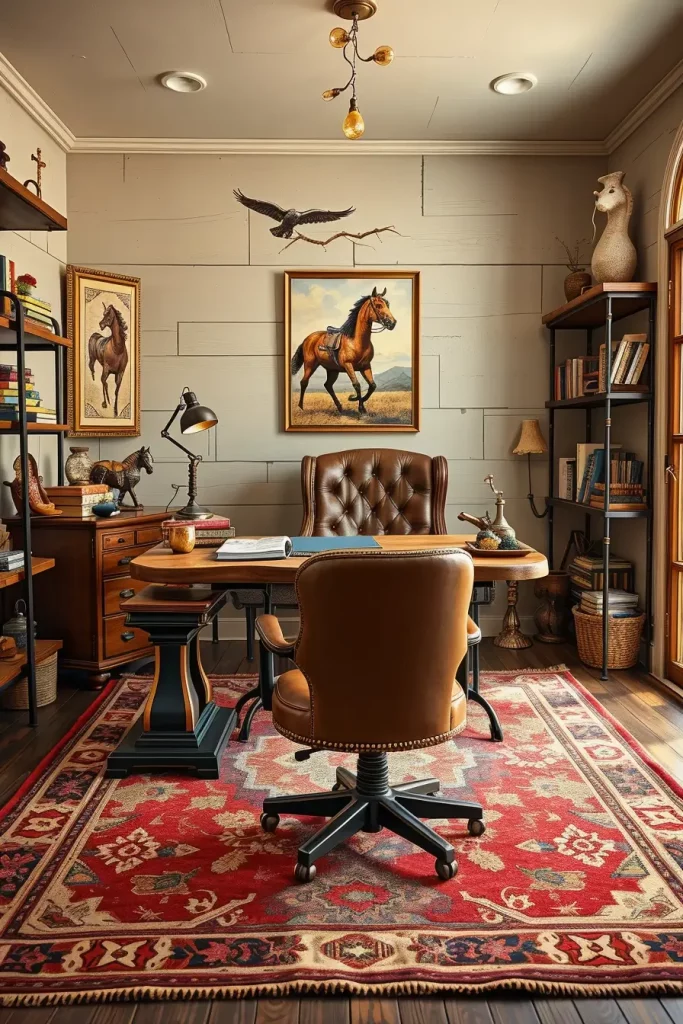
In my own workspace, I added some leather bound journals, a brass pencil holder, and a vintage desk lamp with a patina finish. For a practical-yet stylish design, along with modern functions, like a built-in charging station, Architectural Digest suggests combining vintage and modern elements.
To wrap everything up in style, I would suggest putting in a cowhide chair mat, a wooden ceiling fan, or maybe even a small bar cart with a rustic flair for hosting clients.
Rustic Western Decor On A Budget
Building a rustic western interior can still be affordable. With today’s design trends, I’ve built entire rooms off a budget simply by creatively using what I already had, as well as buying from flea markets, secondhand shops, and even local artisans. The critical factor is knowing what you intend to get for the project: authenticity, texture, and character.
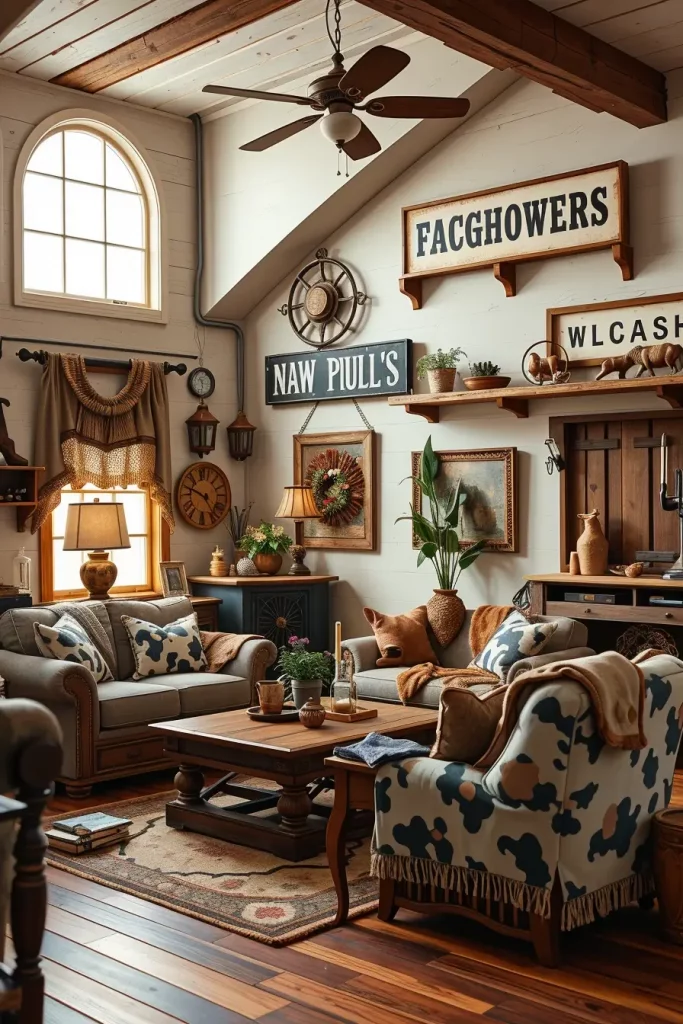
Look out for weathered wood furniture, iron fixtures, vintage signage, and western textiles. Most of these items can easily be found at estate sales or online marketplaces. For budget flying options, distressing new wood or sewing pillow covers out of western fabric can up the authenticity. Charm can also be found within repurposing things as simple as old leather belts for drawer pulls.
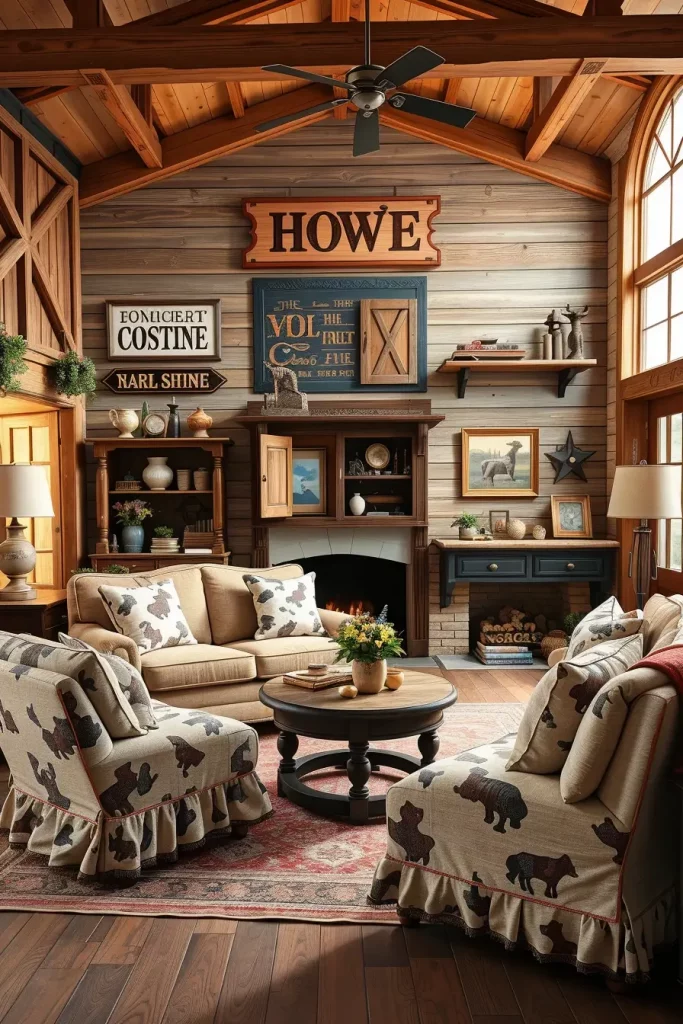
Using hand-me-down furniture, DIY barnwood shelving, and a selection of thrift store treasures, I once completed a western style living room for under $500. Per Real Simple, layering textures with a singular color palette creates a high end look without breaking the bank. This has been simple yet effective guidance for my clients.
For further savings, consider searching upcycled lighting, cow-print slipcovers, and hand-painted signage which would give charm at little expense.
Mixing Western With Other Design Styles
Integrating rustic western decor with other design styles creates unique, customized areas. I admire the western style together with modern, industrial, or even minimalist decor for the contrast it brings. Balancing the harmony of these elements remaining each is crucial.
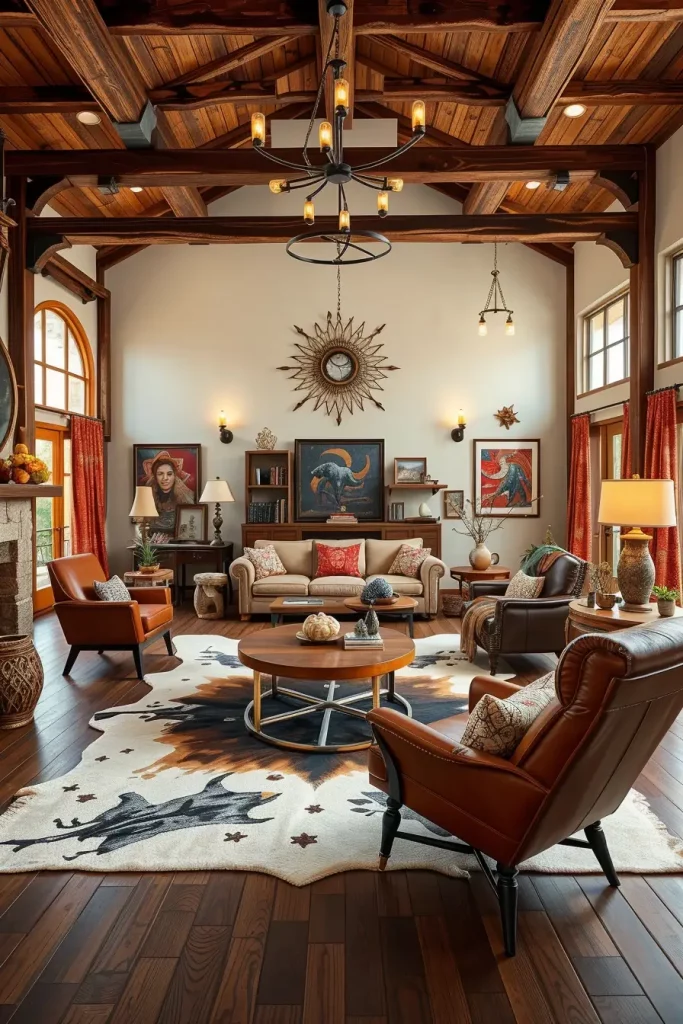
Often, I combine a pair of distressed wood beams and sleek metal sconces or a cowhide rug with mid-century pieces. A contemporary sofa can be dressed in western textiles alongside crisp arms while a clean lined dining table surrounded by leather saddle chairs looks fabulous. Mixing styles provides a chance for every piece to have a story.
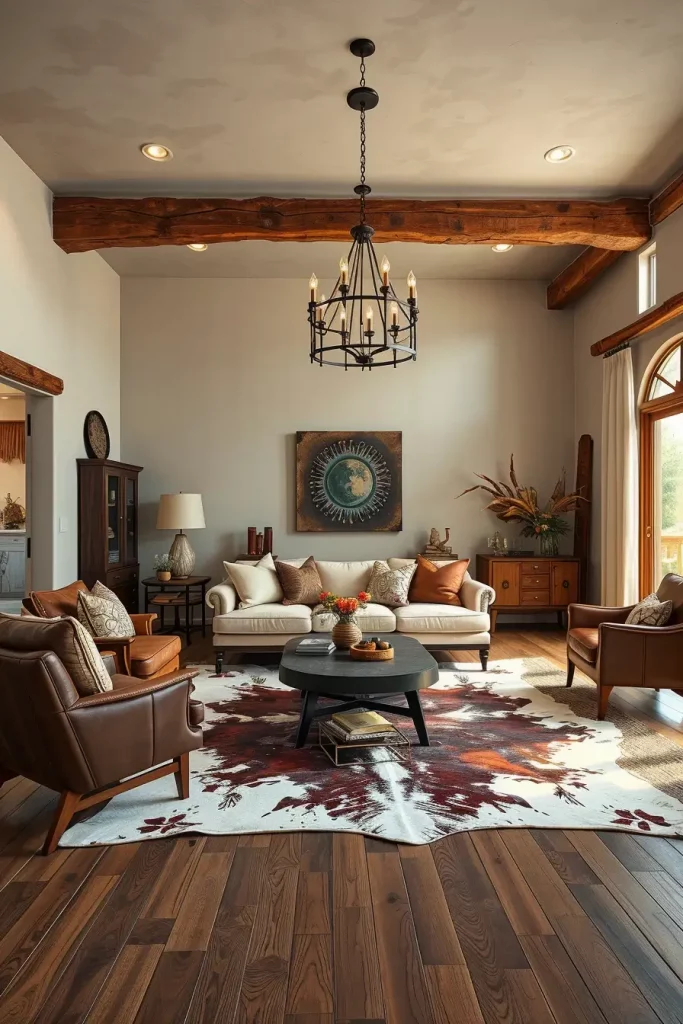
One of my favorite undertakings was adding Western elements to a Scandinavian house by concentrating on tone and texture over patterns. As House Beautiful puts it, “adding one strong western element into a modern space goes a long way” and I could not agree more. It is about pioping rather than clashing.
To further this mixed aesthetic, my goal would be to add a rustic focal point statement wall or accessories from each style scattered throughout the space.
Western Holiday Decor And Seasonal Accents
Incorporating Western flair into seasonal decorating can shift the aesthetic of your home throughout the year while maintaining alignment with your primary style. Moreover, I often assist clients in “Western” holiday decorating because it feels festive, yet, somehow rooted in rustic charm.
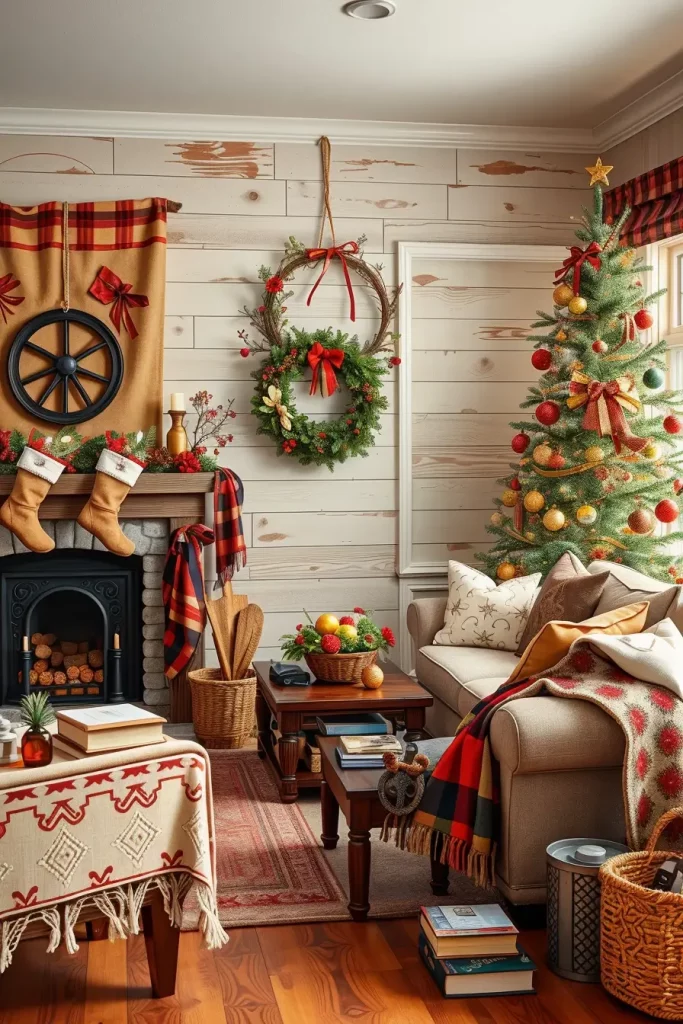
For example, I use burlap stockings and plaid throws for Christmas and hang miniature cowboy boots as ornaments. In the fall, my décor includes hay bales and horseshoe wreaths along with pumpkins arranged in galvanized tubs. I start using more light accents like wild flowers in mason jars or vintage picnic baskets used as décor in spring and summer.
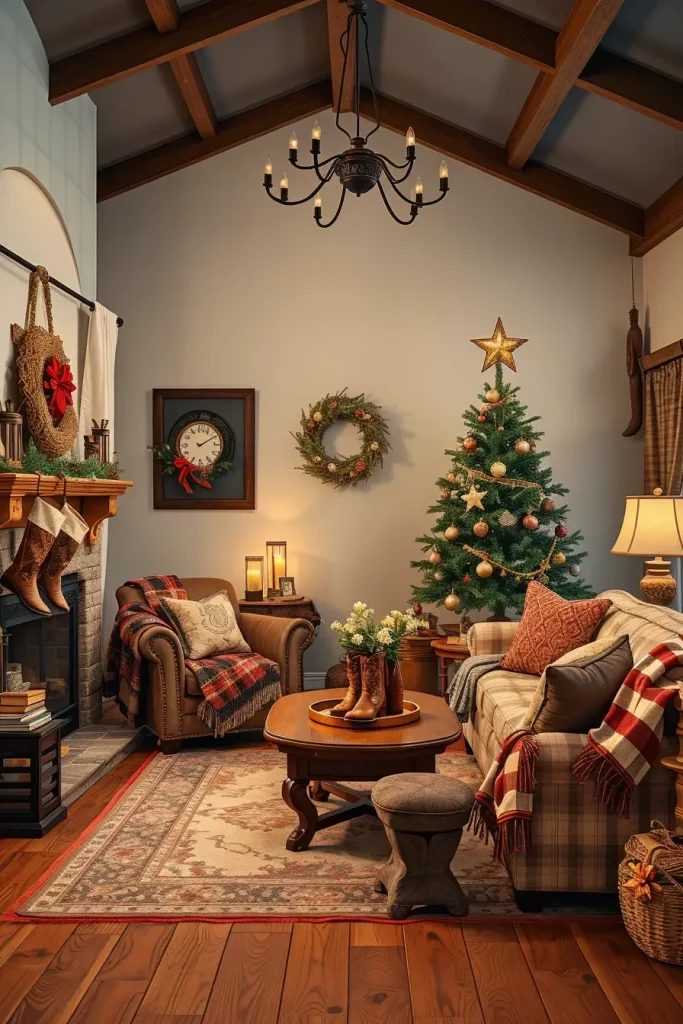
In my own home, I’ve used a pair of leather gloves as stocking holders and I repurposed a saddle blanket into a tree skirt. Southern Living suggests keeping seasonal decor simple, focusing on the natural elements for rustic homes, and I think that preserves authenticity and timelessness, don’t you?
One addition I would suggest is a custom porch sign for each season, like burned into wood or painted on a barn shutter, gives your porch or entry an understated charm.
Using Native American-Inspired Patterns
While designing a rustic western room, the first step I prefer to take is oriented towards the heritage elements of the decor. I think Native American-inspired motifs provide rich culture through their wonderful visual poetic. These designs work best with textiles—imagine throw blankets, beaded pillows and woven rugs—which look great in earth-toned western spaces. Their vivid geometry provides spirited clash with the softened materials of western style interiors like reclaimed wood and wrought iron.
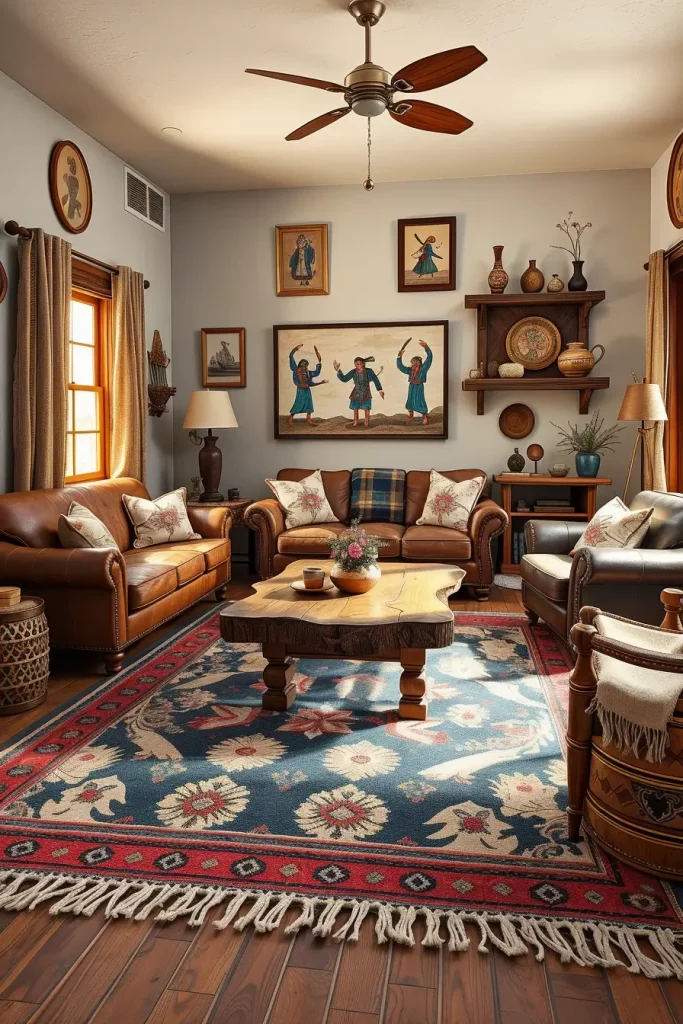
For example, a large woven rug with Navajo or Hopi patterns placed under a low-profile leather couch makes me very happy. This alongside a wooden coffee table makes the whole room feel culturally anchored. For the rest of the walls, I suggest framed tribal prints, Handmade pottery and even a dream catcher above the bed or over the fireplace. The ultimate goal is to respect design, art, and style all at the same time. Authenticity to me means trying to buy modern crafted products or vintage styled items from even ethically sourced stores.
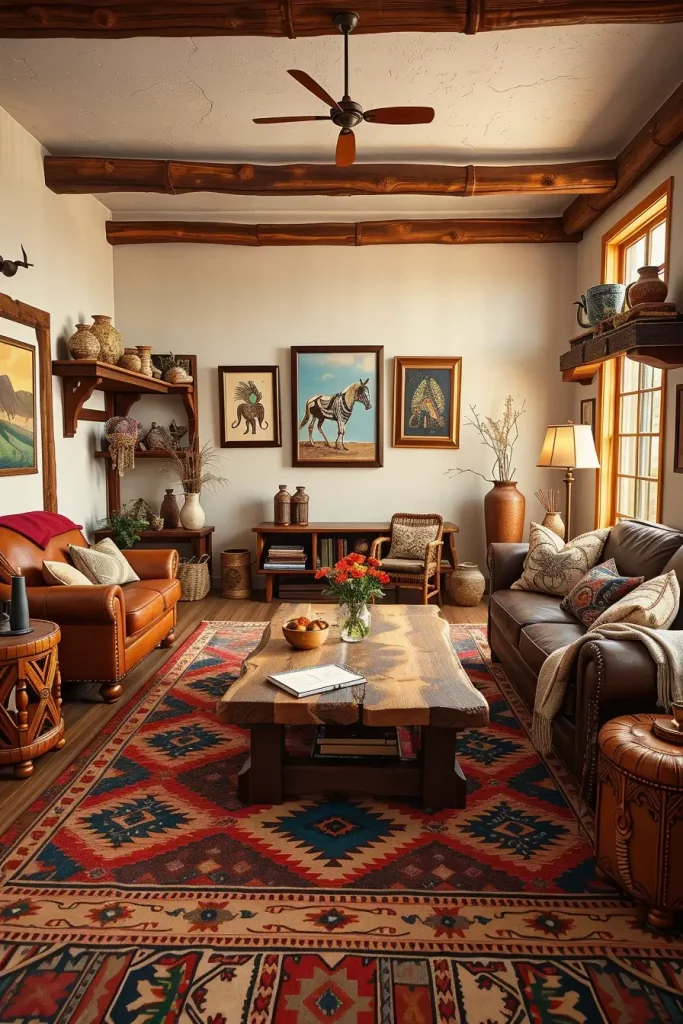
To me, the elements enhance the space aesthetically—and more importantly, they tell a story. It shows that a home containing Native American patterns is integrated thoughtfully and not simply styled. I follow Architectural Digest and Design Milk, and I appreciate how they honor the application of such patterns; they are not honored in any way for them to be used casually.
I would place a couple of clay or ceramic vessels on the side tables and shelving to strengthen this section. This would further soften the permeated warmth in the room and complete the room harmoniously.
Western Storage Solutions With Style
Rustic western home decor is no complete without clever and stylish storage solutions that combine form and function. When designing storage around a western home, I try focusing on pieces that have narrative texture. Vintage trunks, barnwood armoires, and open shelves made of aged timber all come to mind. These pieces do not merely serve to conceal the jumble of items. Instead, they aid in the decoration and strengthen the home’s frontier theme.

For my personal work, I enjoy adding a reclaimed wood bench seat with cubbies and a hinged lid for boots and blankets by the entryway. I also use galvanized steel baskets in open shelving units along with wrought iron wall hooks that are designed as horseshoes or longhorns. Open bookcases can be decorated with leather bound journals, old lanterns, and cowboy hats for both style and function. With these furnishings, storing items becomes delightful visually.
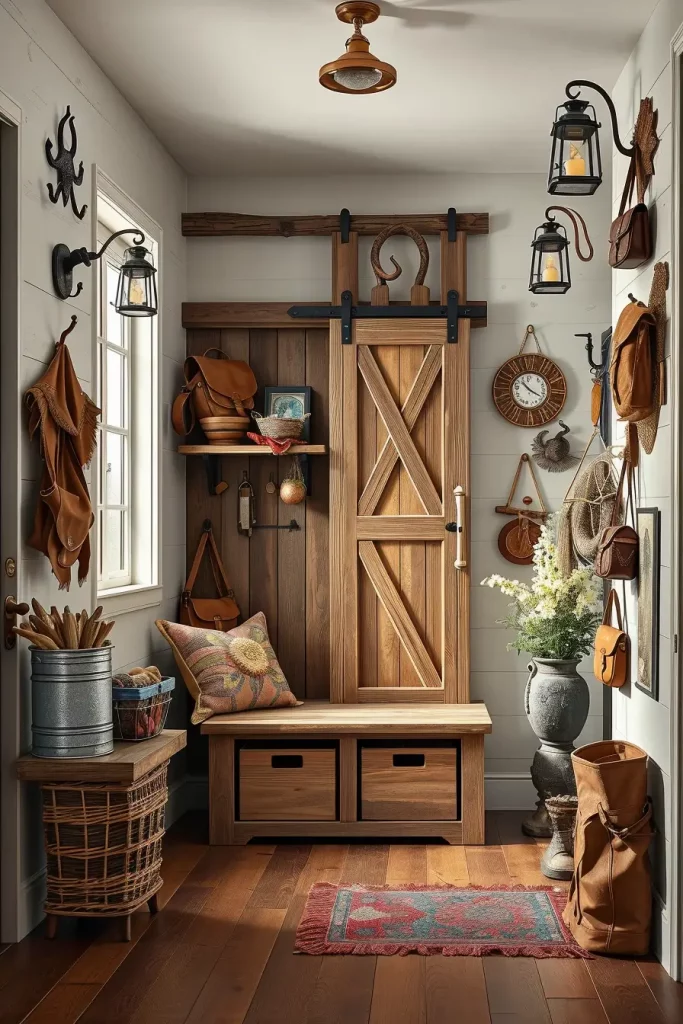
As to my own preferences, I’d say well crafted storage spaces are one of the most neglected aspects of western decor. Candidly, most homeowners place emphasis on aesthetics but rather helpful is what enables a space to endure. Elle Decor suggests western homes greatly benfit from lived-in, cozy appearing spaces—comfort and clutter effortlessly tied together due to strategically concealed element—walls, boxes, and dual purpose furniture such as trunks sofas, or ottomans, which should dominate a room’s clean lines at optimal sight height.
To complete arranging this room, I would add tall cabinets with raw metal door handles or sliding barn doors. This accents the polished rustic edge feel of the room, adding height to the southward horizontal expanse of benches and baskets, creating powerful vertical stroke.
How To Shop For Rustic Western Home Decor
Shopping for rustic western home decor can be rewarding, particularly when you know what to do. For western interiors, I typically recommend starting with: wood, leather, iron, and stone. These materials are pivotal as they anchor any authentic western interior. After identifying the key materials, you can begin planning how to complete the rest of the room. Don’t forget to check craftsmanship. Quality, handmade items that won’t last a season will always be worth the investment.
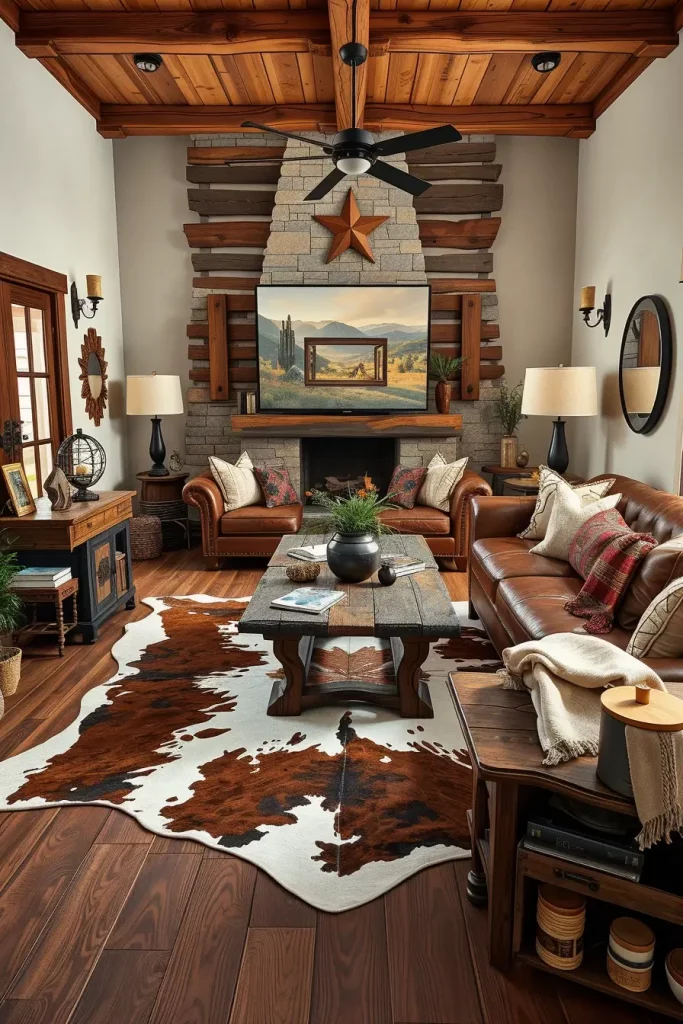
Personally, or for clients, I hunt for articles such as saddle leather chairs, wool textiles with bold patterns, and distressed wood tables. Antiques shops and flea markets, along with specialty boutiques that focus on western decor, usually have unique items which capture my attention. Artisans specializing in rustic and western styles often prefer sites like Etsy which makes it easy for everyone to find cowhide rugs or cast iron wall sconces. Reclaimed wood panels also serve as an example as these items are essential in every interior design for character and warmth.
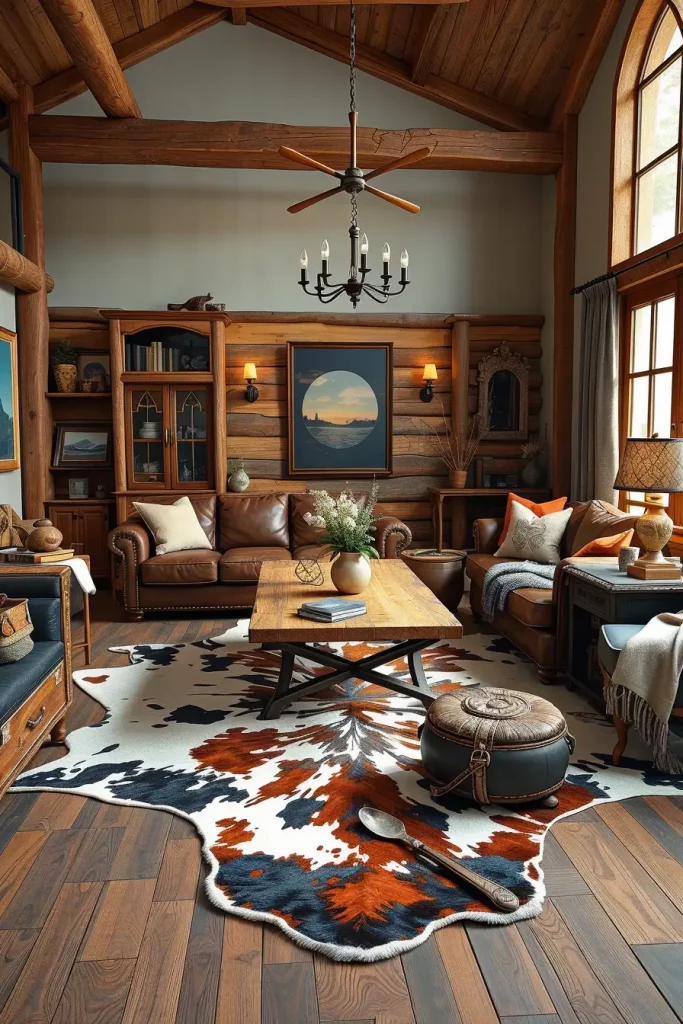
No doubt, it was Country Living Magazine that gave me the best advice: mix high and low. Throw a luxurious leather sectional next to a hand-me-down coffee table or even an antique crate side table. This look, like many others, prevents the room from feeling overly designed, which is essential for western rooms so that they do not feel stuffy.
What I would recommend adding here is the components of the color palette. Look for saddle brown, burnt sienna, ochre, sage green, ivory. These colors are tones that blend beautifully while providing any space a warm, western natural glow.
Final Tips For Achieving Western Coziness
As a decorator, when I get asked how to achieve cozy feels with rustic western home decor, I always say focus on warmth, texture and lighting. Start off with warm bulbs everywhere, paired with soft ambient lights instead of harsh overheads. Cosy blankets on sofas and animal hides on wooden floors plus linen drapes on the windows all come together beautifully to create this peaceful lodge-like atmosphere filled with western comfort.
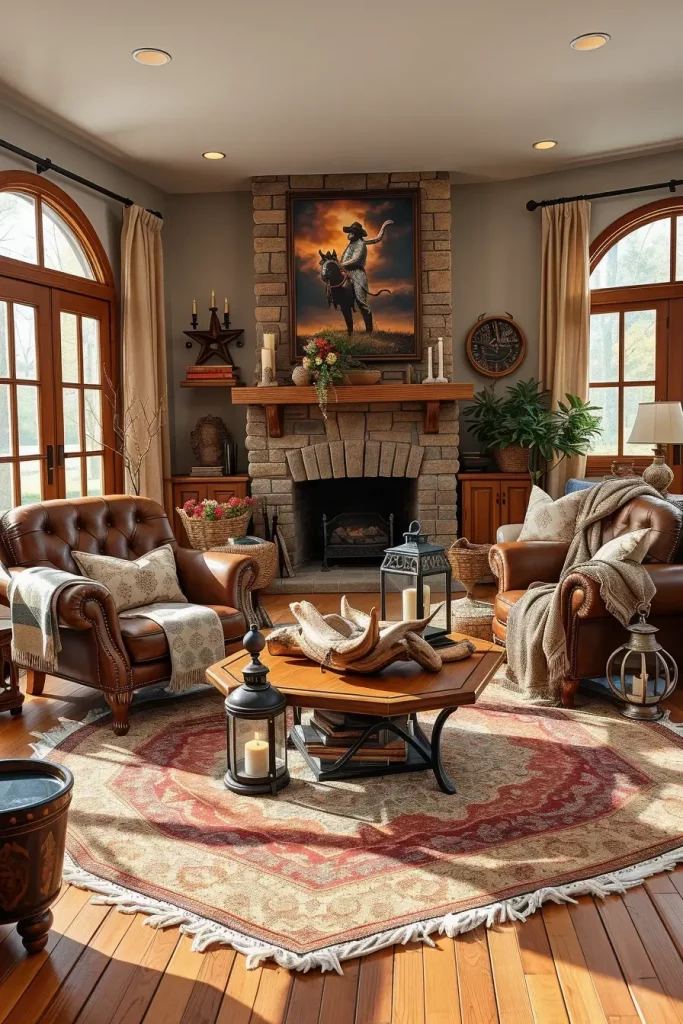
When it comes to furniture, I gravitate toward large, soft-seated furniture such as tufted leather armchairs and deep couches with rawhide trim. Pair these with vintage landscape oil paintings of canyons or wild horses, newly framed wood mirrors and hand-stitched cushions. Subtle scent design also appeals to me, so I make sure to incorporate leather candles and cedarwood diffusers. These are the types of details that guests remember, which enrich a space and give it true character.
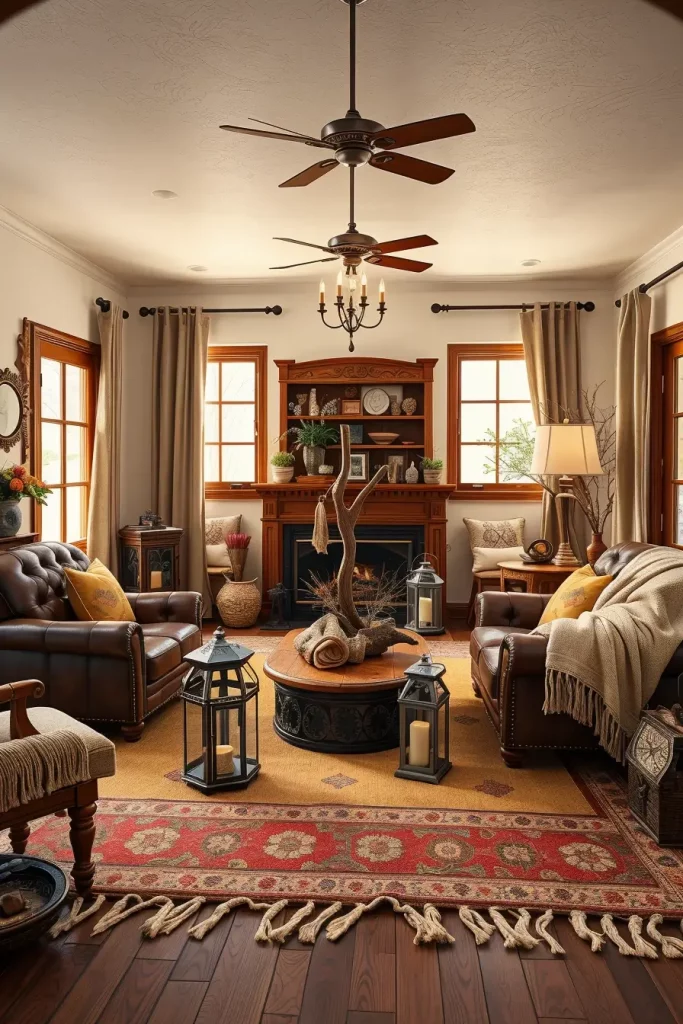
For my own home, I’ve added layered wool rugs over stone tile floors which I enhanced further with dimmable wrought iron sconces for mood lighting in the evenings. Following the advice of Better Homes and Gardens, I’ve incorporated more natural elements with driftwood centerpieces and feathered wall decor, helping to soften aesthetics and improve comfort. Daylight can be gently diffused with draperies made of natural fibers, such as Roman shades, which I also encourage.
What is often lacking in a lot of west-themed homes is vegetation. A few terracotta pots with desert flowers or low-maintenance succulents can easily elevate the space without straying too far from the rustic theme.
Rustic Western home decor isn’t just a style; it cultivates a sense of identity, warmth, and nostalgia. Incorporating natural elements, genuine western design, and carefully selected textures will create a home that feels personal and timeless. I would love to learn how you’re incorporating this into your home. Feel free to leave questions or ideas in the comments section!
